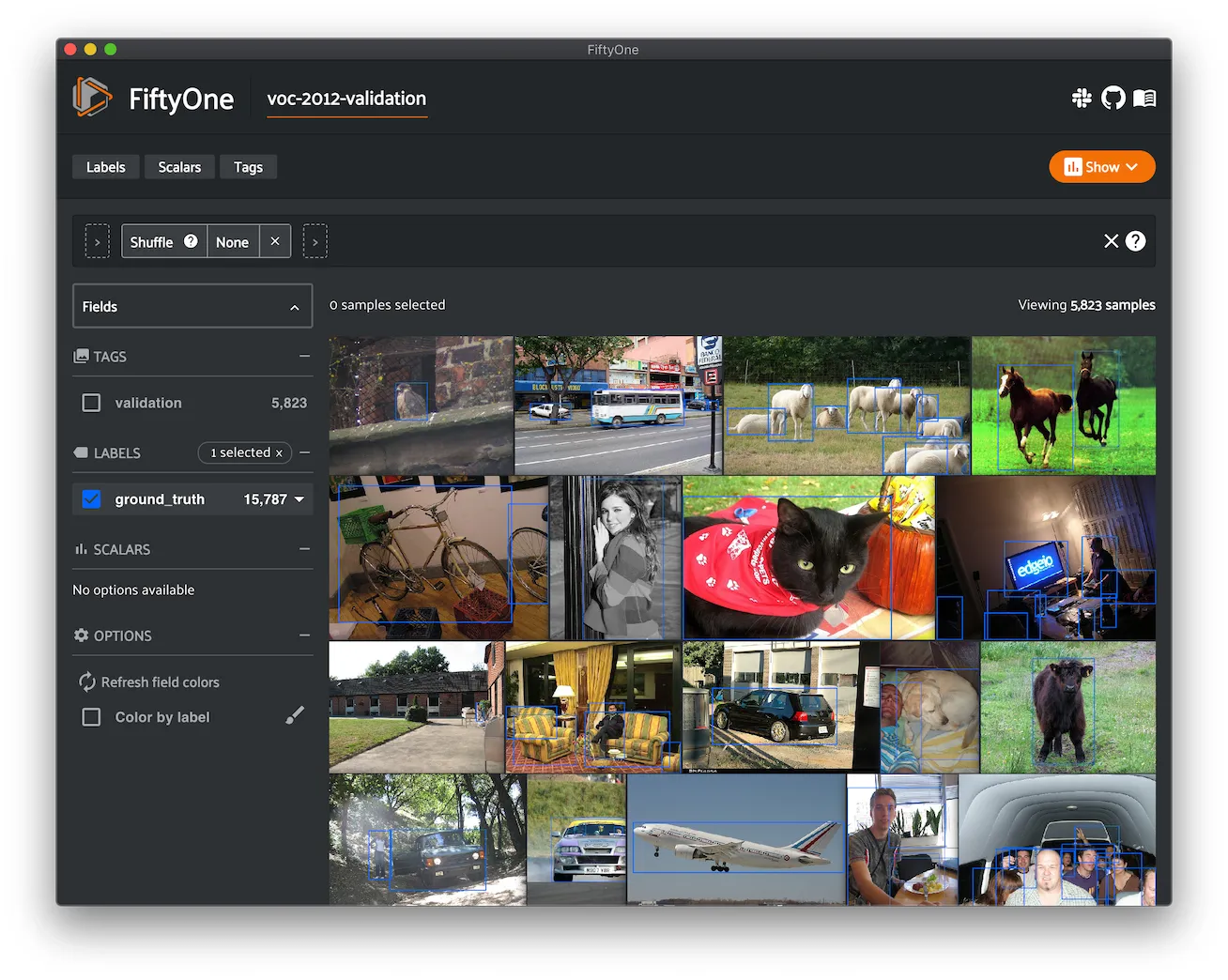Built-In Zoo Datasets ¶¶
This page lists all of the natively available datasets in the FiftyOne Dataset Zoo.
Check out the API reference for complete instructions for using the Dataset Zoo.
Note
Some datasets are loaded via the TorchVision Datasets or TensorFlow Datasets packages under the hood.
If you do not have a suitable package installed when attempting to download a zoo dataset, you’ll see an error message that will help you install one.
| Dataset name | Tags |
|---|---|
| ActivityNet 100 | video, classification, action-recognition, temporal-detection |
| ActivityNet 200 | video, classification, action-recognition, temporal-detection |
| BDD100K | image, multilabel, automotive, manual |
| Caltech-101 | image, classification |
| Caltech-256 | image, classification |
| CIFAR-10 | image, classification |
| CIFAR-100 | image, classification |
| Cityscapes | image, multilabel, automotive, manual |
| COCO-2014 | image, detection, segmentation |
| COCO-2017 | image, detection, segmentation |
| Fashion MNIST | image, classification |
| Families in the Wild | image, classification |
| HMDB51 | video, action-recognition |
| ImageNet 2012 | image, classification, manual |
| ImageNet Sample | image, classification |
| Kinetics 400 | video, classification, action-recognition |
| Kinetics 600 | video, classification, action-recognition |
| Kinetics 700 | video, classification, action-recognition |
| Kinetics 700-2020 | video, classification, action-recognition |
| KITTI | image, detection |
| KITTI Multiview | image, point-cloud, detection |
| Labeled Faces in the Wild | image, classification, facial-recognition |
| MNIST | image, classification |
| Open Images V6 | image, classification, detection, segmentation, relationships |
| Open Images V7 | image, classification, detection, segmentation, keypoints, relationships |
| Places | image, classification |
| Quickstart | image, quickstart |
| Quickstart Geo | image, location, quickstart |
| Quickstart Video | video, quickstart |
| Quickstart Groups | image, point-cloud, quickstart |
| Quickstart 3D | 3d, point-cloud, mesh, quickstart |
| Sama-COCO | image, detection, segmentation |
| UCF101 | video, action-recognition |
| VOC-2007 | image, detection |
| VOC-2012 | image, detection |
ActivityNet 100 ¶¶
ActivityNet is a large-scale video dataset for human activity understanding supporting the tasks of global video classification, trimmed activity classification, and temporal activity detection.
This version contains videos and temporal activity detections for the 100 class version of the dataset.
Note
Check out this guide for more details on using FiftyOne to work with ActivityNet.
Notes
-
ActivityNet 100 and 200 differ in the number of activity classes and videos per split
-
Partial downloads will download videos (if still available) from YouTube
-
Full splits can be loaded by first downloading the official source files from the ActivityNet maintainers
-
The test set does not have annotations
Details
-
Dataset name:
activitynet-100 -
Dataset source: http://activity-net.org/index.html
-
Dataset size: 223 GB
-
Tags:
video, classification, action-recognition, temporal-detection -
Supported splits:
train, validation, test -
ZooDataset class:
ActivityNet100Dataset
Full split stats
-
Train split: 4,819 videos (7,151 instances)
-
Test split: 2,480 videos (labels withheld)
-
Validation split: 2,383 videos (3,582 instances)
Partial downloads
FiftyOne provides parameters that can be used to efficiently download specific subsets of the ActivityNet dataset to suit your needs. When new subsets are specified, FiftyOne will use existing downloaded data first if possible before resorting to downloading additional data from YouTube.
The following parameters are available to configure a partial download of
ActivityNet 100 by passing them to
load_zoo_dataset():
-
split ( None) and splits ( None): a string or list of strings, respectively, specifying the splits to load. Supported values are
("train", "test", "validation"). If none are provided, all available splits are loaded -
source_dir ( None): the directory containing the manually downloaded ActivityNet files used to avoid downloading videos from YouTube
-
classes ( None): a string or list of strings specifying required classes to load. If provided, only samples containing at least one instance of a specified class will be loaded
-
max_duration ( None): only videos with a duration in seconds that is less than or equal to the
max_durationwill be downloaded. By default, all videos are downloaded -
copy_files ( True): whether to move (False) or create copies (True) of the source files when populating
dataset_dir. This is only relevant when asource_diris provided -
num_workers ( None): the number of processes to use when downloading individual videos. By default,
multiprocessing.cpu_count()is used -
shuffle ( False): whether to randomly shuffle the order in which samples are chosen for partial downloads
-
seed ( None): a random seed to use when shuffling
-
max_samples ( None): a maximum number of samples to load per split. If
classesare also specified, only up to the number of samples that contain at least one specified class will be loaded. By default, all matching samples are loaded
Note
See
ActivityNet100Dataset and
ActivityNetDatasetImporter
for complete descriptions of the optional keyword arguments that you can
pass to load_zoo_dataset().
Full split downloads
Many videos have been removed from YouTube since the creation of ActivityNet. As a result, if you do not specify any partial download parameters defined in the previous section, you must first download the official source files from the ActivityNet maintainers in order to load a full split into FiftyOne.
To download the source files, you must fill out this form.
Refer to this page to see how to load
full splits by passing the source_dir parameter to
load_zoo_dataset().
Example usage
Note
In order to work with video datasets, you’ll need to have ffmpeg installed).

ActivityNet 200 ¶¶
ActivityNet is a large-scale video dataset for human activity understanding supporting the tasks of global video classification, trimmed activity classification, and temporal activity detection.
This version contains videos and temporal activity detections for the 200 class version of the dataset.
Note
Check out this guide for more details on using FiftyOne to work with ActivityNet.
Notes
-
ActivityNet 200 is a superset of ActivityNet 100
-
ActivityNet 100 and 200 differ in the number of activity classes and videos per split
-
Partial downloads will download videos (if still available) from YouTube
-
Full splits can be loaded by first downloading the official source files from the ActivityNet maintainers
-
The test set does not have annotations
Details
-
Dataset name:
activitynet-200 -
Dataset source: http://activity-net.org/index.html
-
Dataset size: 500 GB
-
Tags:
video, classification, action-recognition, temporal-detection -
Supported splits:
train, validation, test -
ZooDataset class:
ActivityNet200Dataset
Full split stats
-
Train split: 10,024 videos (15,410 instances)
-
Test split: 5,044 videos (labels withheld)
-
Validation split: 4,926 videos (7,654 instances)
Partial downloads
FiftyOne provides parameters that can be used to efficiently download specific subsets of the ActivityNet dataset to suit your needs. When new subsets are specified, FiftyOne will use existing downloaded data first if possible before resorting to downloading additional data from YouTube.
The following parameters are available to configure a partial download of
ActivityNet 200 by passing them to
load_zoo_dataset():
-
split ( None) and splits ( None): a string or list of strings, respectively, specifying the splits to load. Supported values are
("train", "test", "validation"). If none are provided, all available splits are loaded -
source_dir ( None): the directory containing the manually downloaded ActivityNet files used to avoid downloading videos from YouTube
-
classes ( None): a string or list of strings specifying required classes to load. If provided, only samples containing at least one instance of a specified class will be loaded
-
max_duration ( None): only videos with a duration in seconds that is less than or equal to the
max_durationwill be downloaded. By default, all videos are downloaded -
copy_files ( True): whether to move (False) or create copies (True) of the source files when populating
dataset_dir. This is only relevant when asource_diris provided -
num_workers ( None): the number of processes to use when downloading individual videos. By default,
multiprocessing.cpu_count()is used -
shuffle ( False): whether to randomly shuffle the order in which samples are chosen for partial downloads
-
seed ( None): a random seed to use when shuffling
-
max_samples ( None): a maximum number of samples to load per split. If
classesare also specified, only up to the number of samples that contain at least one specified class will be loaded. By default, all matching samples are loaded
Note
See
ActivityNet200Dataset and
ActivityNetDatasetImporter
for complete descriptions of the optional keyword arguments that you can
pass to load_zoo_dataset().
Full split downloads
Many videos have been removed from YouTube since the creation of ActivityNet. As a result, if you do not specify any partial download parameters defined in the previous section, you must first download the official source files from the ActivityNet maintainers in order to load a full split into FiftyOne.
To download the source files, you must fill out this form.
Refer to this page to see how to load
full splits by passing the source_dir parameter to
load_zoo_dataset().
Example usage
Note
In order to work with video datasets, you’ll need to have ffmpeg installed).
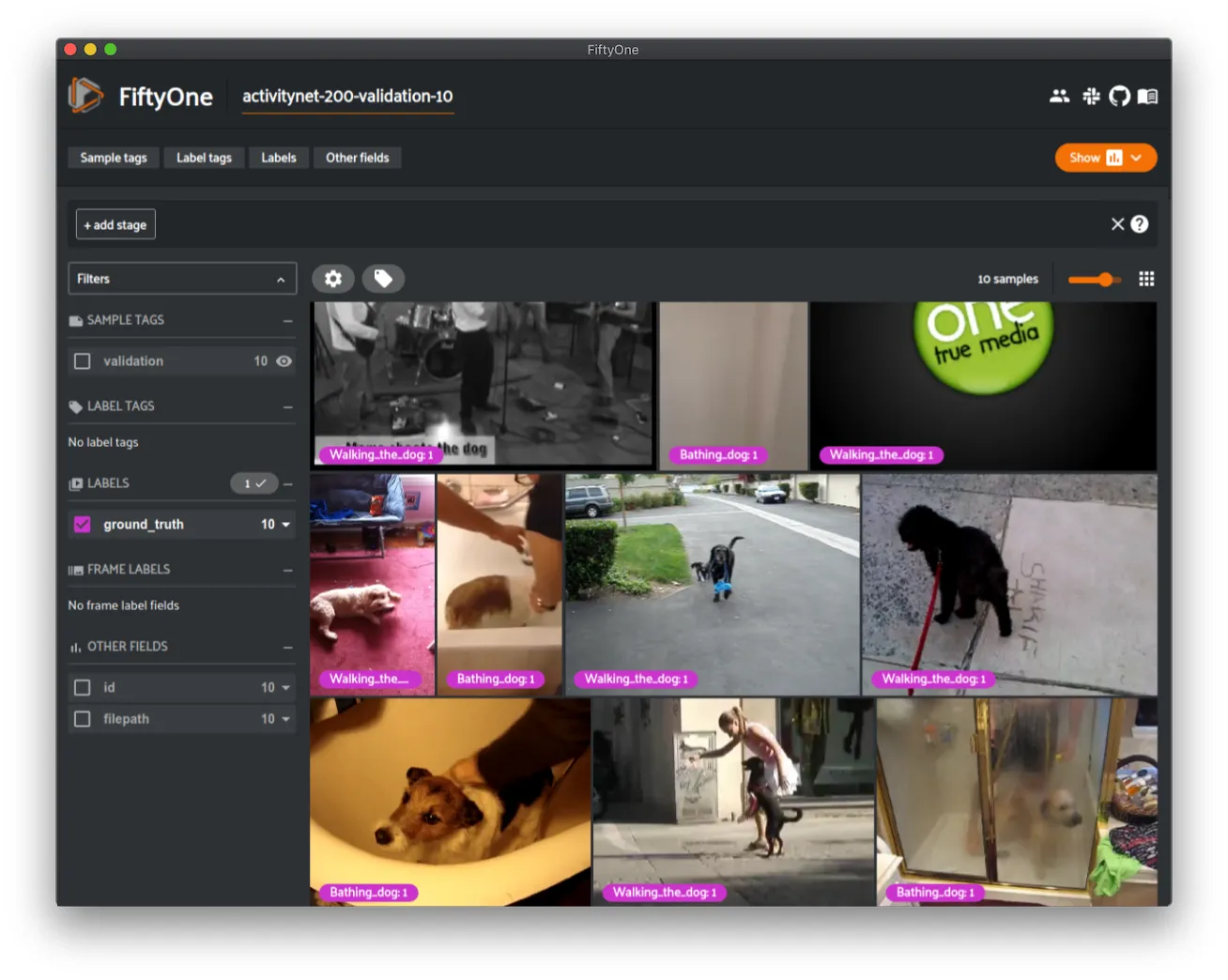
BDD100K ¶¶
The Berkeley Deep Drive (BDD) dataset is one of the largest and most diverse video datasets for autonomous vehicles.
The BDD100K dataset contains 100,000 video clips collected from more than 50,000 rides covering New York, San Francisco Bay Area, and other regions. The dataset contains diverse scene types such as city streets, residential areas, and highways. Furthermore, the videos were recorded in diverse weather conditions at different times of the day.
The videos are split into training (70K), validation (10K) and testing (20K) sets. Each video is 40 seconds long with 720p resolution and a frame rate of 30fps. The frame at the 10th second of each video is annotated for image classification, detection, and segmentation tasks.
This version of the dataset contains only the 100K images extracted from the videos as described above, together with the image classification, detection, and segmentation labels.
Note
In order to load the BDD100K dataset, you must download the source data manually. The directory should be organized in the following format:
source_dir/
labels/
bdd100k_labels_images_train.json
bdd100k_labels_images_val.json
images/
100k/
train/
test/
val/
You can register at https://bdd-data.berkeley.edu in order to get links to download the data.
Details
-
Dataset name:
bdd100k -
Dataset source: https://bdd-data.berkeley.edu
-
Dataset size: 7.10 GB
-
Tags:
image, multilabel, automotive, manual -
Supported splits:
train, validation, test -
ZooDataset class:
BDD100KDataset
Example usage

Caltech-101 ¶¶
The Caltech-101 dataset of images.
The dataset consists of pictures of objects belonging to 101 classes, plus
one background clutter class ( BACKGROUND_Google). Each image is labelled
with a single object.
Each class contains roughly 40 to 800 images, totalling around 9,000 images. Images are of variable sizes, with typical edge lengths of 200-300 pixels. This version contains image-level labels only.
Details
-
Dataset name:
caltech101 -
Dataset source: https://data.caltech.edu/records/mzrjq-6wc02
-
Dataset size: 138.60 MB
-
Tags:
image, classification -
Supported splits:
N/A -
ZooDataset class:
Caltech101Dataset
Example usage

Caltech-256 ¶¶
The Caltech-256 dataset of images.
The dataset consists of pictures of objects belonging to 256 classes, plus
one background clutter class ( clutter). Each image is labelled with a
single object.
Each class contains between 80 and 827 images, totalling 30,607 images. Images are of variable sizes, with typical edge lengths of 80-800 pixels.
Details
-
Dataset name:
caltech256 -
Dataset source: https://data.caltech.edu/records/nyy15-4j048
-
Dataset size: 1.16 GB
-
Tags:
image, classification -
Supported splits:
N/A -
ZooDataset class:
Caltech256Dataset
Example usage
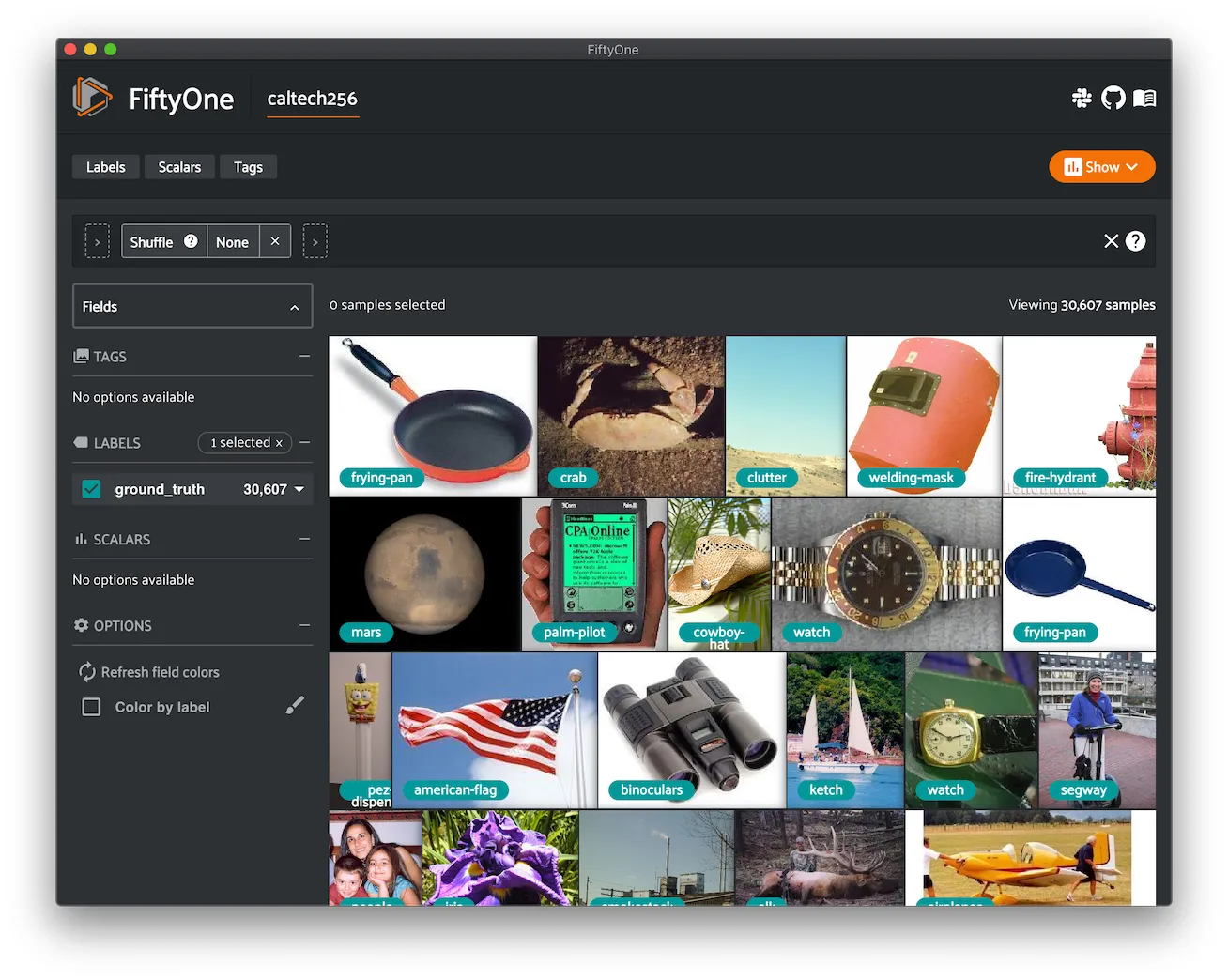
CIFAR-10 ¶¶
The CIFAR-10 dataset of images.
The dataset consists of 60,000 32 x 32 color images in 10 classes, with 6,000 images per class. There are 50,000 training images and 10,000 test images.
Details
-
Dataset name:
cifar10 -
Dataset source: https://www.cs.toronto.edu/~kriz/cifar.html
-
Dataset size: 132.40 MB
-
Tags:
image, classification -
Supported splits:
train, test -
ZooDataset classes:
-
CIFAR10Dataset(TF backend) -
CIFAR10Dataset(Torch backend)
Note
You must have the Torch or TensorFlow backend(s) installed to load this dataset.
Example usage
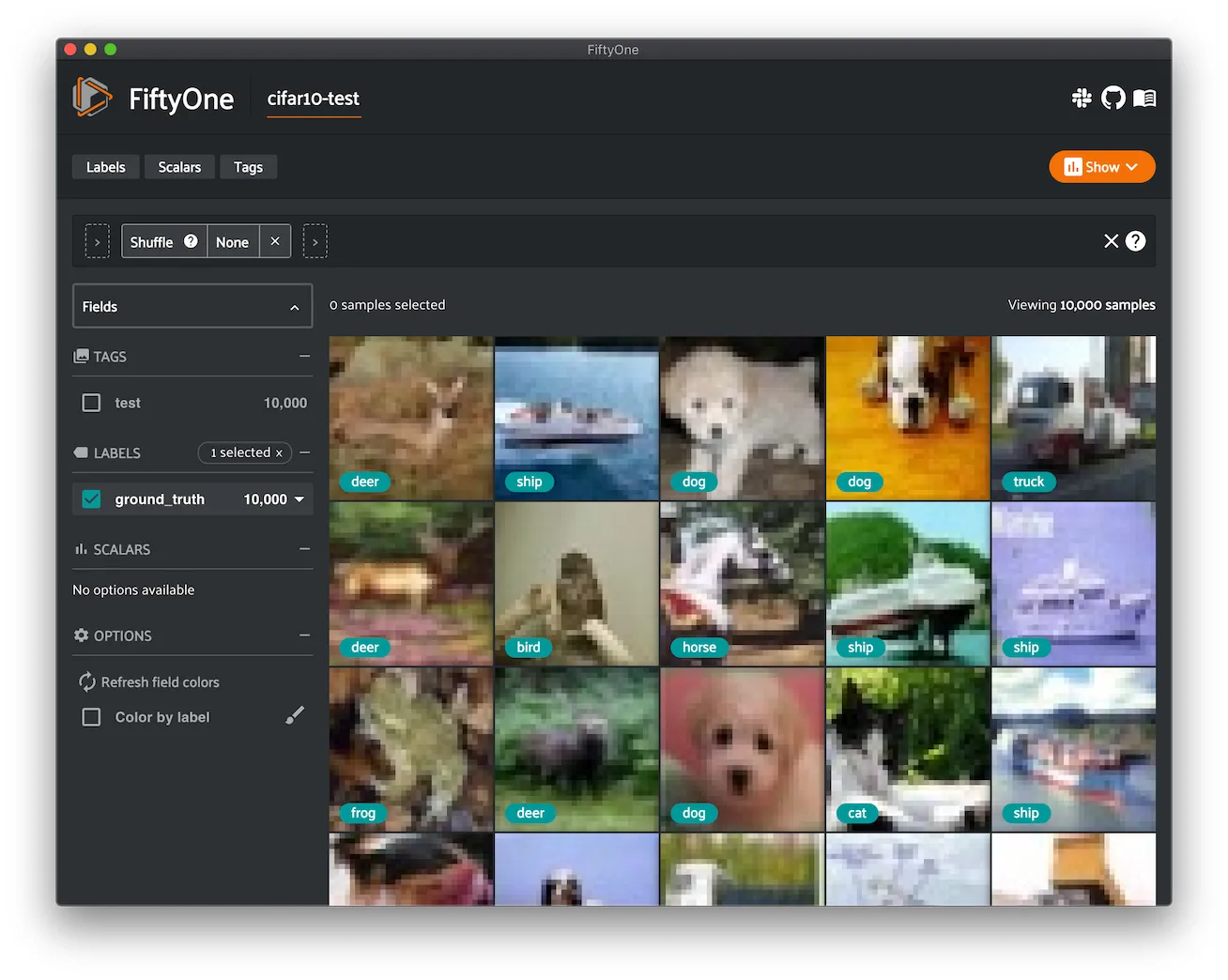
CIFAR-100 ¶¶
The CIFAR-100 dataset of images.
The dataset consists of 60,000 32 x 32 color images in 100 classes, with 600 images per class. There are 50,000 training images and 10,000 test images.
Details
-
Dataset name:
cifar100 -
Dataset source: https://www.cs.toronto.edu/~kriz/cifar.html
-
Dataset size: 132.03 MB
-
Tags:
image, classification -
Supported splits:
train, test -
ZooDataset classes:
-
CIFAR100Dataset(TF backend) -
CIFAR100Dataset(Torch backend)
Note
You must have the Torch or TensorFlow backend(s) installed to load this dataset.
Example usage
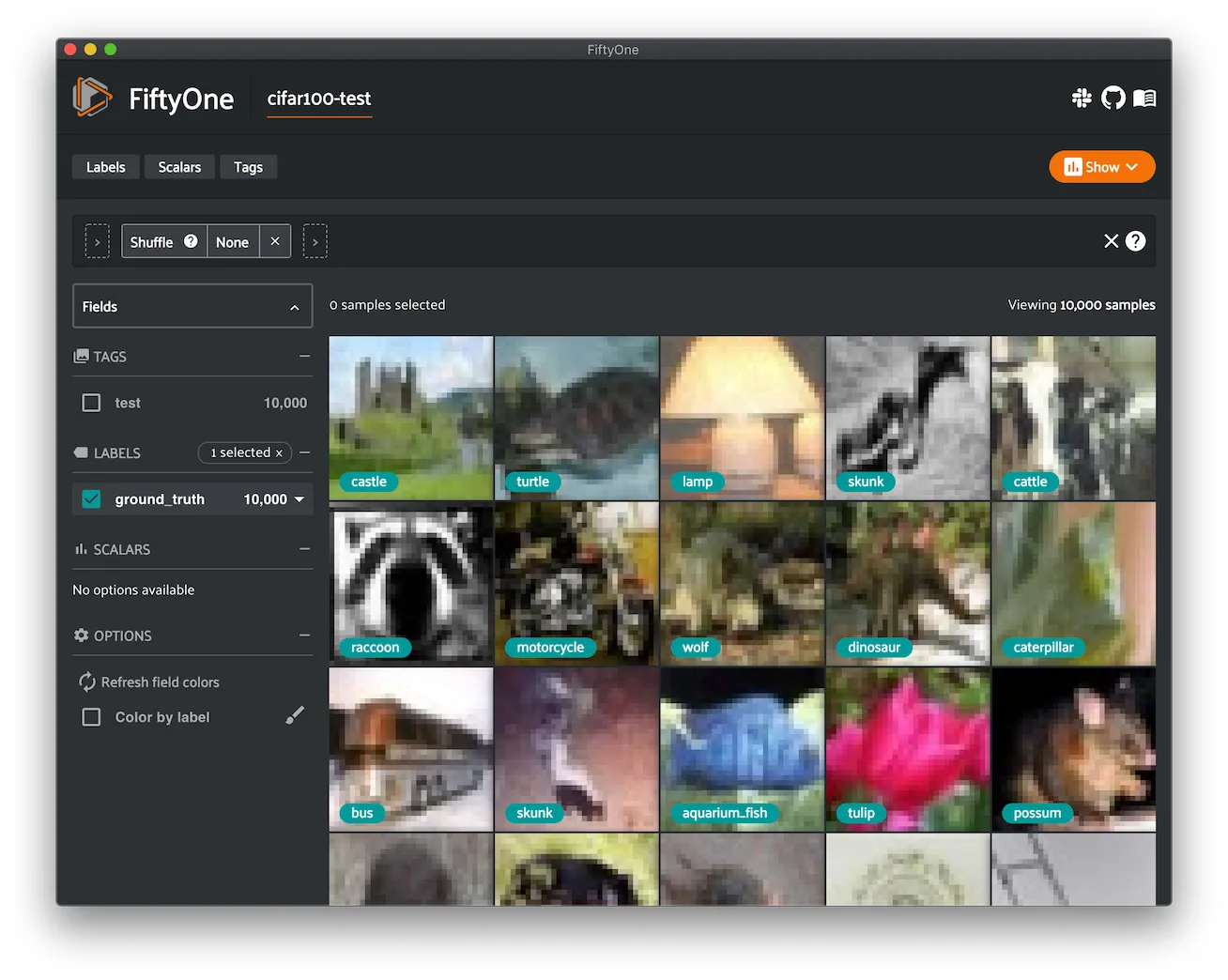
Cityscapes ¶¶
Cityscapes is a large-scale dataset that contains a diverse set of stereo video sequences recorded in street scenes from 50 different cities, with high quality pixel-level annotations of 5,000 frames in addition to a larger set of 20,000 weakly annotated frames.
The dataset is intended for:
-
Assessing the performance of vision algorithms for major tasks of semantic urban scene understanding: pixel-level, instance-level, and panoptic semantic labeling
-
Supporting research that aims to exploit large volumes of (weakly) annotated data, e.g. for training deep neural networks
Note
In order to load the Cityscapes dataset, you must download the source data manually. The directory should be organized in the following format:
source_dir/
leftImg8bit_trainvaltest.zip
gtFine_trainvaltest.zip # optional
gtCoarse.zip # optional
gtBbox_cityPersons_trainval.zip # optional
You can register at https://www.cityscapes-dataset.com/register in order to get links to download the data.
Details
-
Dataset name:
cityscapes -
Dataset source: https://www.cityscapes-dataset.com
-
Dataset size: 11.80 GB
-
Tags:
image, multilabel, automotive, manual -
Supported splits:
train, validation, test -
ZooDataset class:
CityscapesDataset
Example usage
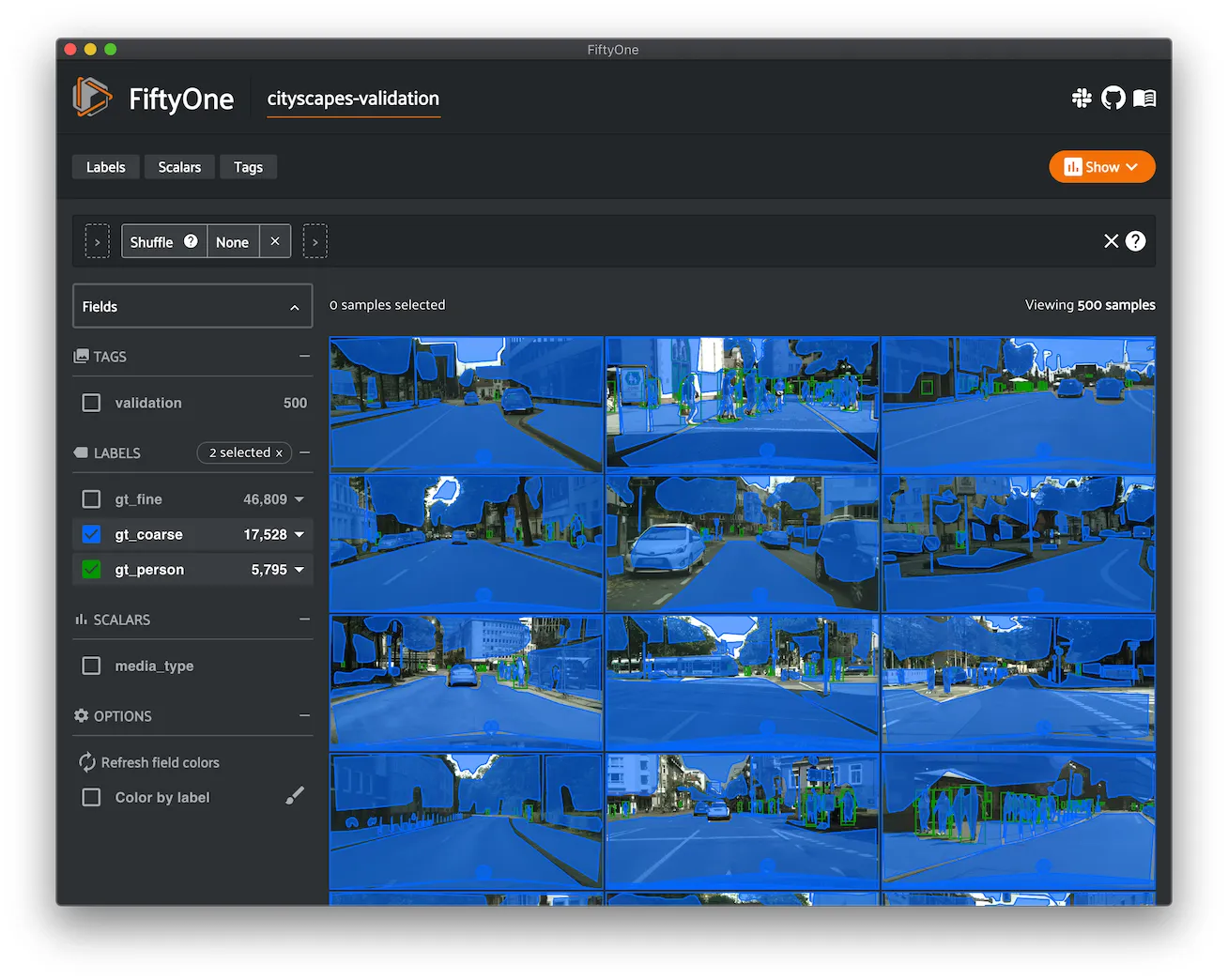
COCO-2014 ¶¶
COCO is a large-scale object detection, segmentation, and captioning dataset.
This version contains images, bounding boxes, and segmentations for the 2014 version of the dataset.
Note
With support from the COCO team, FiftyOne is a recommended tool for downloading, visualizing, and evaluating on the COCO dataset!
Check out this guide for more details on using FiftyOne to work with COCO.
Notes
-
COCO defines 91 classes but the data only uses 80 classes
-
Some images from the train and validation sets don’t have annotations
-
The test set does not have annotations
-
COCO 2014 and 2017 use the same images, but the splits are different
Details
-
Dataset name:
coco-2014 -
Dataset source: http://cocodataset.org/#home
-
Dataset size: 37.57 GB
-
Tags:
image, detection, segmentation -
Supported splits:
train, validation, test -
ZooDataset class:
COCO2014Dataset
Full split stats
-
Train split: 82,783 images
-
Test split: 40,775 images
-
Validation split: 40,504 images
Partial downloads
FiftyOne provides parameters that can be used to efficiently download specific subsets of the COCO dataset to suit your needs. When new subsets are specified, FiftyOne will use existing downloaded data first if possible before resorting to downloading additional data from the web.
The following parameters are available to configure a partial download of
COCO-2014 by passing them to
load_zoo_dataset():
-
split ( None) and splits ( None): a string or list of strings, respectively, specifying the splits to load. Supported values are
("train", "test", "validation"). If neither is provided, all available splits are loaded -
label_types ( None): a label type or list of label types to load. Supported values are
("detections", "segmentations"). By default, only detections are loaded -
classes ( None): a string or list of strings specifying required classes to load. If provided, only samples containing at least one instance of a specified class will be loaded
-
image_ids ( None): a list of specific image IDs to load. The IDs can be specified either as
<split>/<image-id>strings or<image-id>ints of strings. Alternatively, you can provide the path to a TXT (newline-separated), JSON, or CSV file containing the list of image IDs to load in either of the first two formats -
include_id ( False): whether to include the COCO ID of each sample in the loaded labels
-
include_license ( False): whether to include the COCO license of each sample in the loaded labels, if available. The supported values are:
-
"False"(default): don’t load the license -
True/"name": store the string license name -
"id": store the integer license ID -
"url": store the license URL -
only_matching ( False): whether to only load labels that match the
classesorattrsrequirements that you provide (True), or to load all labels for samples that match the requirements (False) -
num_workers ( None): the number of processes to use when downloading individual images. By default,
multiprocessing.cpu_count()is used -
shuffle ( False): whether to randomly shuffle the order in which samples are chosen for partial downloads
-
seed ( None): a random seed to use when shuffling
-
max_samples ( None): a maximum number of samples to load per split. If
label_typesand/orclassesare also specified, first priority will be given to samples that contain all of the specified label types and/or classes, followed by samples that contain at least one of the specified labels types or classes. The actual number of samples loaded may be less than this maximum value if the dataset does not contain sufficient samples matching your requirements
Note
See
COCO2014Dataset and
COCODetectionDatasetImporter
for complete descriptions of the optional keyword arguments that you can
pass to load_zoo_dataset().
Example usage
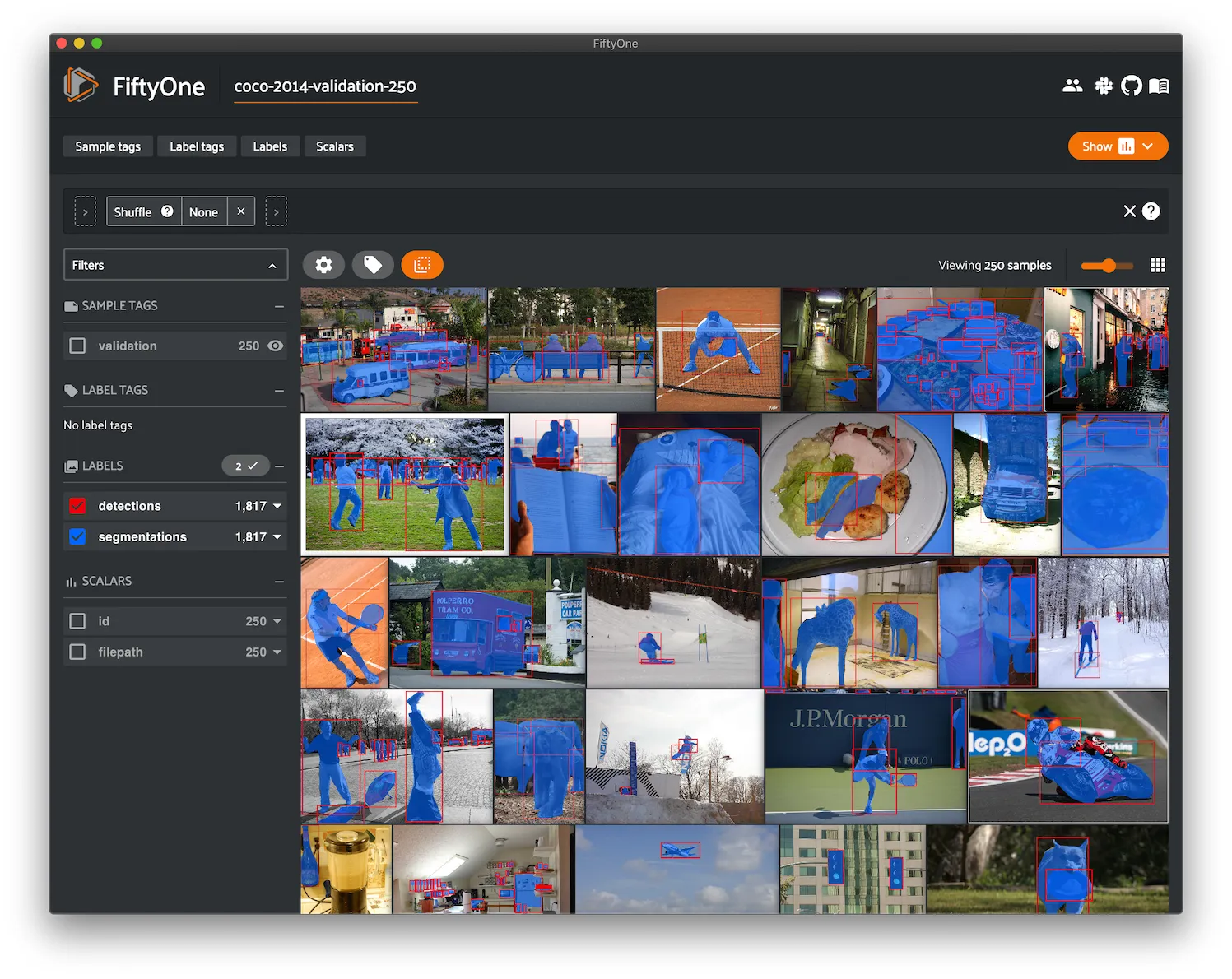
COCO-2017 ¶¶
COCO is a large-scale object detection, segmentation, and captioning dataset.
This version contains images, bounding boxes, and segmentations for the 2017 version of the dataset.
Note
With support from the COCO team, FiftyOne is a recommended tool for downloading, visualizing, and evaluating on the COCO dataset!
Check out this guide for more details on using FiftyOne to work with COCO.
Notes
-
COCO defines 91 classes but the data only uses 80 classes
-
Some images from the train and validation sets don’t have annotations
-
The test set does not have annotations
-
COCO 2014 and 2017 use the same images, but the splits are different
Details
-
Dataset name:
coco-2017 -
Dataset source: http://cocodataset.org/#home
-
Dataset size: 25.20 GB
-
Tags:
image, detection, segmentation -
Supported splits:
train, validation, test -
ZooDataset class:
COCO2017Dataset
Full split stats
-
Train split: 118,287 images
-
Test split: 40,670 images
-
Validation split: 5,000 images
Partial downloads
FiftyOne provides parameters that can be used to efficiently download specific subsets of the COCO dataset to suit your needs. When new subsets are specified, FiftyOne will use existing downloaded data first if possible before resorting to downloading additional data from the web.
The following parameters are available to configure a partial download of
COCO-2017 by passing them to
load_zoo_dataset():
-
split ( None) and splits ( None): a string or list of strings, respectively, specifying the splits to load. Supported values are
("train", "test", "validation"). If neither is provided, all available splits are loaded -
label_types ( None): a label type or list of label types to load. Supported values are
("detections", "segmentations"). By default, only detections are loaded -
classes ( None): a string or list of strings specifying required classes to load. If provided, only samples containing at least one instance of a specified class will be loaded
-
image_ids ( None): a list of specific image IDs to load. The IDs can be specified either as
<split>/<image-id>strings or<image-id>ints of strings. Alternatively, you can provide the path to a TXT (newline-separated), JSON, or CSV file containing the list of image IDs to load in either of the first two formats -
include_id ( False): whether to include the COCO ID of each sample in the loaded labels
-
include_license ( False): whether to include the COCO license of each sample in the loaded labels, if available. The supported values are:
-
"False"(default): don’t load the license -
True/"name": store the string license name -
"id": store the integer license ID -
"url": store the license URL -
only_matching ( False): whether to only load labels that match the
classesorattrsrequirements that you provide (True), or to load all labels for samples that match the requirements (False) -
num_workers ( None): the number of processes to use when downloading individual images. By default,
multiprocessing.cpu_count()is used -
shuffle ( False): whether to randomly shuffle the order in which samples are chosen for partial downloads
-
seed ( None): a random seed to use when shuffling
-
max_samples ( None): a maximum number of samples to load per split. If
label_typesand/orclassesare also specified, first priority will be given to samples that contain all of the specified label types and/or classes, followed by samples that contain at least one of the specified labels types or classes. The actual number of samples loaded may be less than this maximum value if the dataset does not contain sufficient samples matching your requirements
Note
See
COCO2017Dataset and
COCODetectionDatasetImporter
for complete descriptions of the optional keyword arguments that you can
pass to load_zoo_dataset().
Example usage
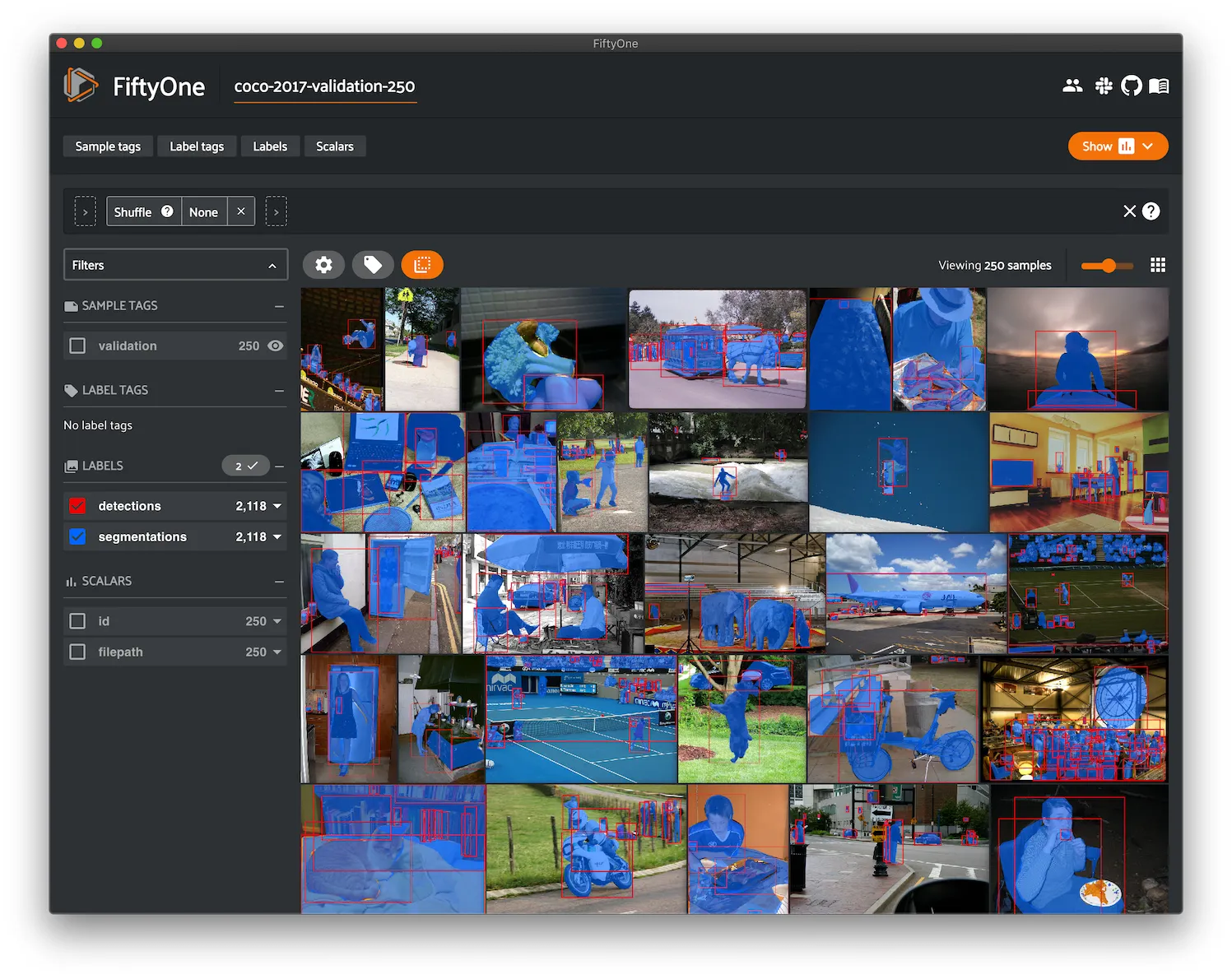
Fashion MNIST ¶¶
The Fashion-MNIST database of Zalando’s fashion article images.
The dataset consists of 70,000 28 x 28 grayscale images in 10 classes. There are 60,000 training images and 10,000 test images.
Details
-
Dataset name:
fashion-mnist -
Dataset source: https://github.com/zalandoresearch/fashion-mnist
-
Dataset size: 36.42 MB
-
Tags:
image, classification -
Supported splits:
train, test -
ZooDataset classes:
-
FashionMNISTDataset(TF backend) -
FashionMNISTDataset(Torch backend)
Note
You must have the Torch or TensorFlow backend(s) installed to load this dataset.
Example usage
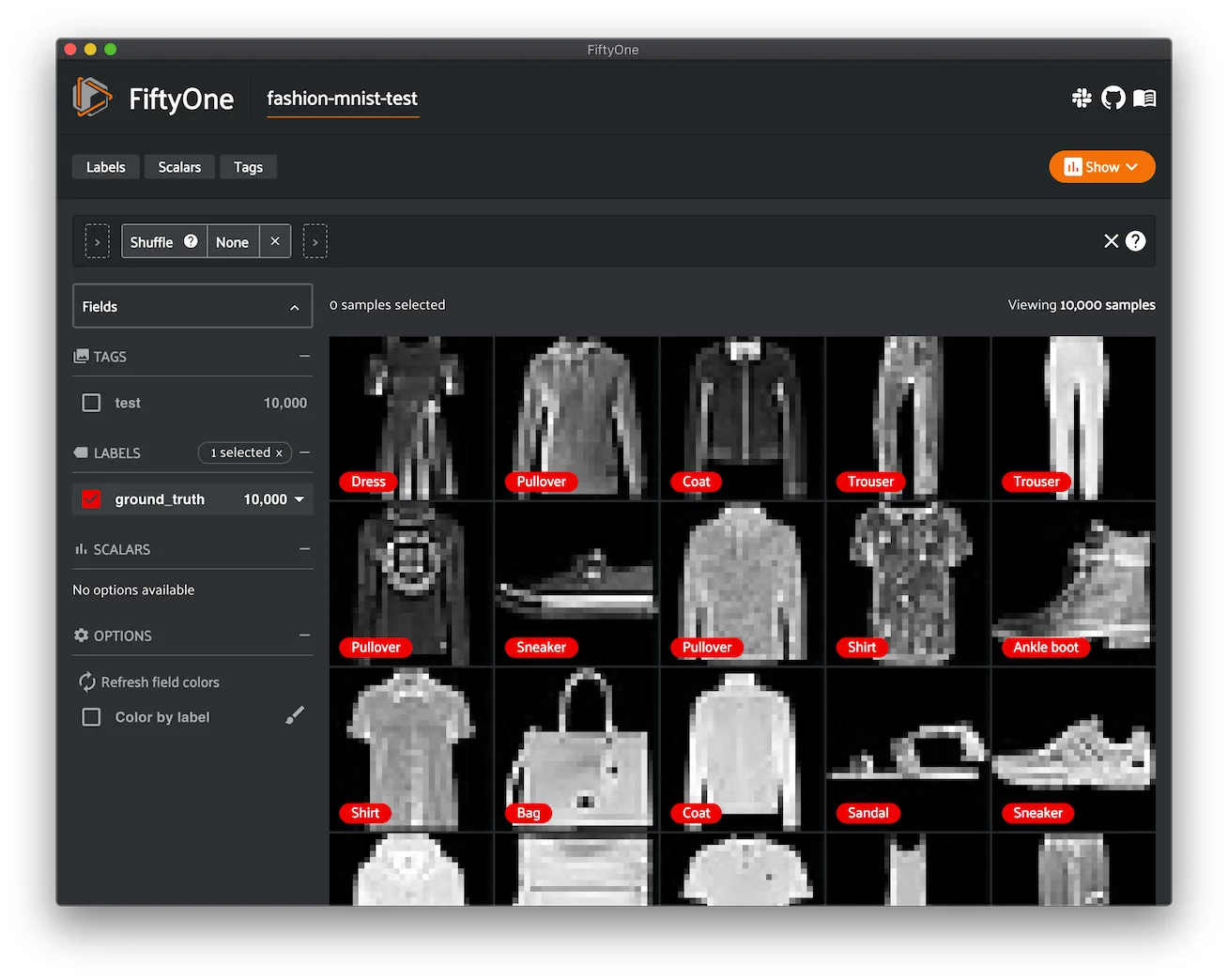
Families in the Wild ¶¶
Families in the Wild is a public benchmark for recognizing families via facial images. The dataset contains over 26,642 images of 5,037 faces collected from 978 families. A unique Family ID (FID) is assigned per family, ranging from F0001-F1018 (i.e., some families were merged or removed since its first release in 2016). The dataset is a continued work in progress. Any contributions are both welcome and appreciated!
Faces were cropped from imagery using the five-point face detector MTCNN from various phototypes (i.e., mostly family photos, along with several profile pics of individuals (facial shots). The number of members per family varies from 3-to-26, with the number of faces per subject ranging from 1 to >10.
Various levels and types of labels are associated with samples in this dataset. Family-level labels contain a list of members, each assigned a member ID (MID) unique to that respective family (e.g., F0011.MID2 refers to member 2 of family 11). Each member has annotations specifying gender and relationship to all other members in that respective family.
The relationships in FIW are:
===== =====
ID Type
===== =====
0 not related or self
1 child
2 sibling
3 grandchild
4 parent
5 spouse
6 grandparent
7 great grandchild
8 great grandparent
9 TBD
===== =====
Within FiftyOne, each sample corresponds to a single face image and contains primitive labels of the Family ID, Member ID, etc. The relationship labels are stored as multi-label classifications, where each classification represents one relationship that the member has with another member in the family. The number of relationships will differ from one person to the next, but all faces of one person will have the same relationship labels.
Additionally, the labels for the
Kinship Verification task
are also loaded into this dataset through FiftyOne. These labels are stored
as classifications just like relationships, but the labels of kinship differ
from those defined above. For example, rather than Parent, the label might be
fd representing a Father-Daughter kinship or md for Mother-Daughter.
In order to make it easier to browse the dataset in the FiftyOne App, each
sample also contains a face_id field containing a unique integer for each
face of a member, always starting at 0. This allows you to filter the face_id
field to 0 in the App to show only a single image of each person.
For your reference, the relationship labels are stored in disk in a matrix that provides the relationship of each member with other members of the family as well as names and genders. The i-th rows represent the i-th family member’s relationship to the j-th other members.
For example, FID0001.csv contains:
MID 1 2 3 Name Gender
1 0 4 5 name1 f
2 1 0 1 name2 f
3 5 4 0 name3 m
Here we have three family members, as listed under the MID column (far-left). Each MID reads across its row. We can see that MID1 is related to MID2 by 4 -> 1 (Parent -> Child), which of course can be viewed as the inverse, i.e., MID2 -> MID1 is 1 -> 4. It can also be seen that MID1 and MID3 are spouses of one another, i.e., 5 -> 5.
Note
The spouse label will likely be removed in future version of this dataset. It serves no value to the problem of kinship.
For more information on the data (e.g., statistics, task evaluations, benchmarks, and more), see the recent journal:
Robinson, JP, M. Shao, and Y. Fu. "Survey on the Analysis and Modeling of
Visual Kinship: A Decade in the Making." IEEE Transactions on Pattern
Analysis and Machine Intelligence (PAMI), 2021.
Details
-
Dataset name:
fiw -
Dataset source: https://web.northeastern.edu/smilelab/fiw/
-
Dataset size: 173.00 MB
-
Tags:
image, kinship, verification, classification, search-and-retrieval, facial-recognition -
Supported splits:
test, val, train -
ZooDataset class:
FIWDataset
Note
For your convenience, FiftyOne provides
get_pairwise_labels()
and
get_identifier_filepaths_map()
utilities for FIW.
Example usage
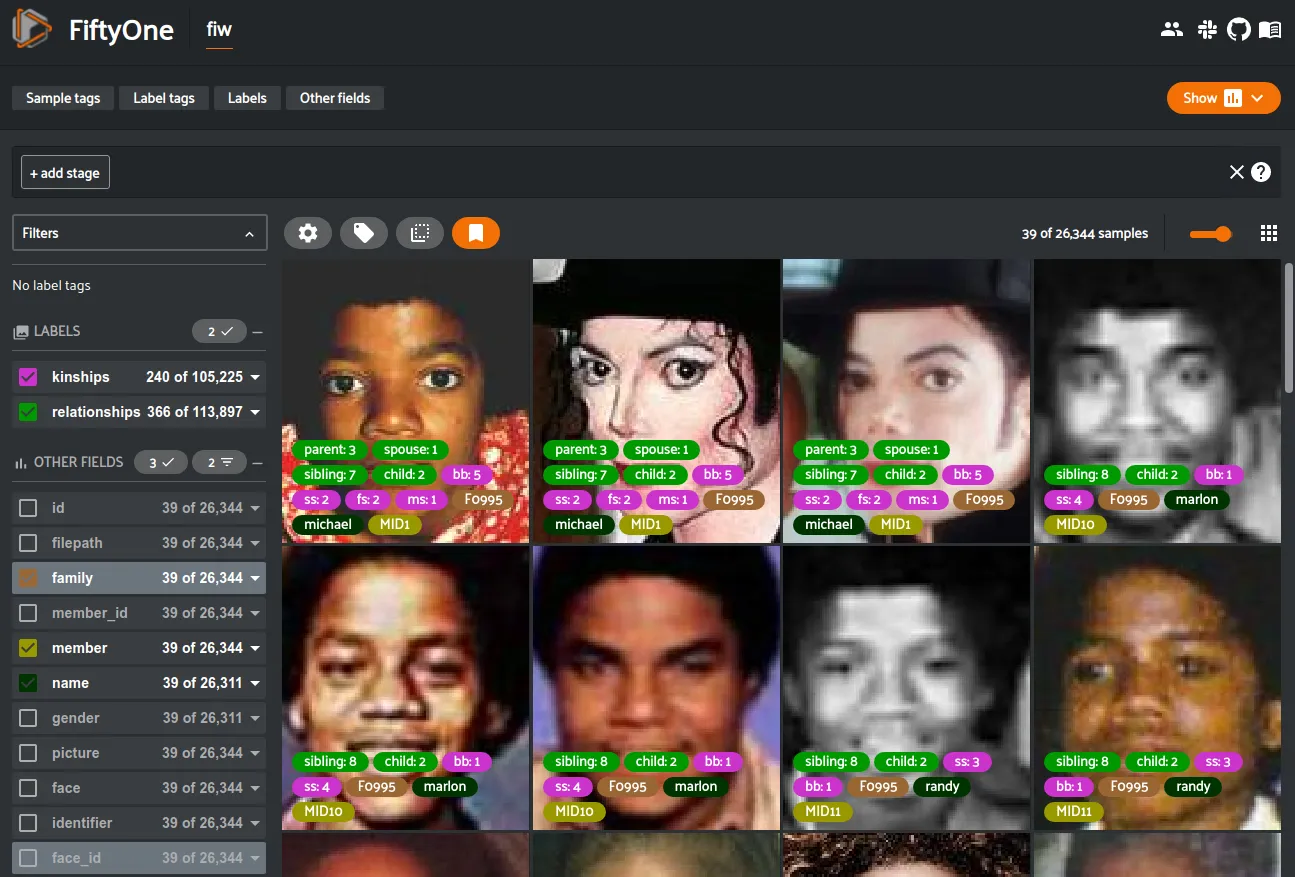
HMBD51 ¶¶
HMDB51 is an action recognition dataset containing a total of 6,766 clips distributed across 51 action classes.
Details
-
Dataset name:
hmdb51 -
Dataset source: https://serre-lab.clps.brown.edu/resource/hmdb-a-large-human-motion-database
-
Dataset size: 2.16 GB
-
Tags:
video, action-recognition -
Supported splits:
train, test, other -
ZooDataset class:
HMDB51Dataset
Example usage
Note
In order to work with video datasets, you’ll need to have ffmpeg installed.
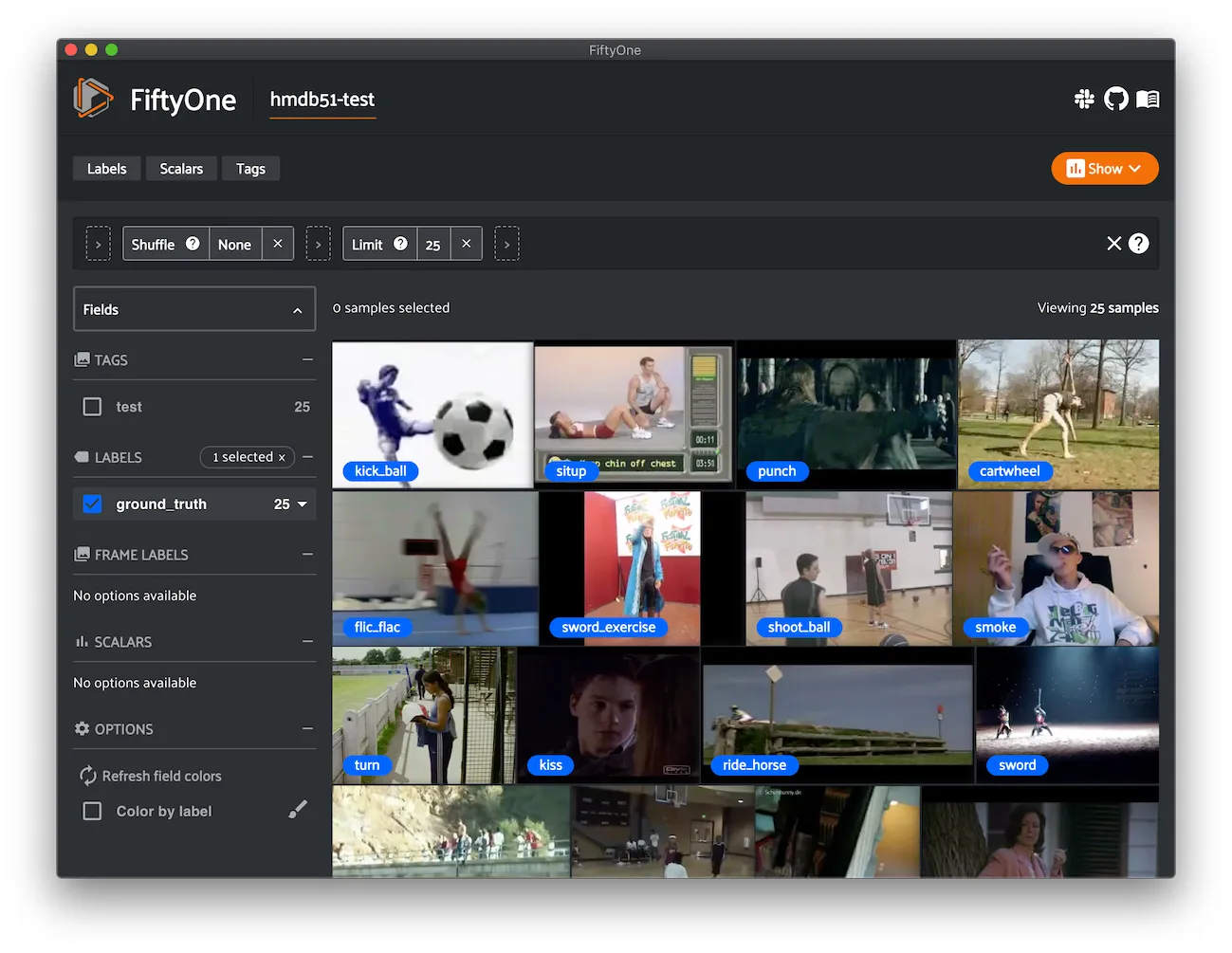
ImageNet 2012 ¶¶
The ImageNet 2012 dataset.
ImageNet, as known as ILSVRC 2012, is an image dataset organized according to the WordNet hierarchy. Each meaningful concept in WordNet, possibly described by multiple words or word phrases, is called a “synonym set” or “synset”. There are more than 100,000 synsets in WordNet, majority of them are nouns (80,000+). ImageNet provides on average 1,000 images to illustrate each synset. Images of each concept are quality-controlled and human-annotated. In its completion, we hope ImageNet will offer tens of millions of cleanly sorted images for most of the concepts in the WordNet hierarchy.
Note that labels were never publicly released for the test set, so only the training and validation sets are provided.
Note
In order to load the ImageNet dataset, you must download the source data manually. The directory should be organized in the following format:
source_dir/
ILSVRC2012_devkit_t12.tar.gz # both splits
ILSVRC2012_img_train.tar # train split
ILSVRC2012_img_val.tar # validation split
You can register at http://www.image-net.org/download-images in order to get links to download the data.
Details
-
Dataset name:
imagenet-2012 -
Dataset source: http://image-net.org
-
Dataset size: 144.02 GB
-
Tags:
image, classification, manual -
Supported splits:
train, validation -
ZooDataset classes:
-
ImageNet2012Dataset(TF backend) -
ImageNet2012Dataset(Torch backend)
Note
You must have the Torch or TensorFlow backend(s) installed to load this dataset.
Example usage
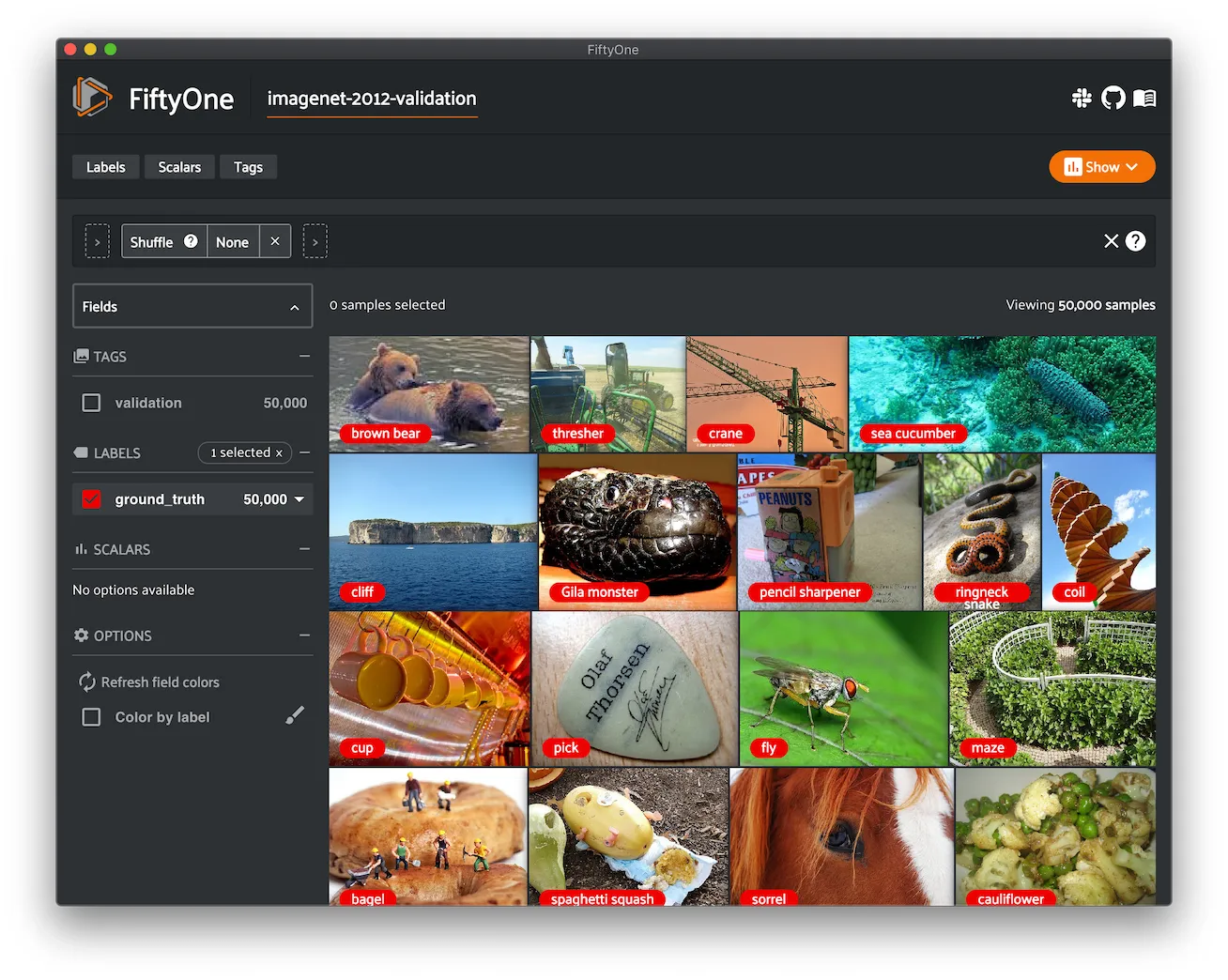
ImageNet Sample ¶¶
A small sample of images from the ImageNet 2012 dataset.
The dataset contains 1,000 images, one randomly chosen from each class of the validation split of the ImageNet 2012 dataset.
These images are provided according to the terms below.
You have been granted access for non-commercial research/educational
use. By accessing the data, you have agreed to the following terms.
You (the "Researcher") have requested permission to use the ImageNet
database (the "Database") at Princeton University and Stanford
University. In exchange for such permission, Researcher hereby agrees
to the following terms and conditions:
1. Researcher shall use the Database only for non-commercial research
and educational purposes.
2. Princeton University and Stanford University make no
representations or warranties regarding the Database, including but
not limited to warranties of non-infringement or fitness for a
particular purpose.
3. Researcher accepts full responsibility for his or her use of the
Database and shall defend and indemnify Princeton University and
Stanford University, including their employees, Trustees, officers
and agents, against any and all claims arising from Researcher's
use of the Database, including but not limited to Researcher's use
of any copies of copyrighted images that he or she may create from
the Database.
4. Researcher may provide research associates and colleagues with
access to the Database provided that they first agree to be bound
by these terms and conditions.
5. Princeton University and Stanford University reserve the right to
terminate Researcher's access to the Database at any time.
6. If Researcher is employed by a for-profit, commercial entity,
Researcher's employer shall also be bound by these terms and
conditions, and Researcher hereby represents that he or she is
fully authorized to enter into this agreement on behalf of such
employer.
7. The law of the State of New Jersey shall apply to all disputes
under this agreement.
Details
-
Dataset name:
imagenet-sample -
Dataset source: http://image-net.org
-
Dataset size: 98.26 MB
-
Tags:
image, classification -
Supported splits:
N/A -
ZooDataset class:
ImageNetSampleDataset
Example usage
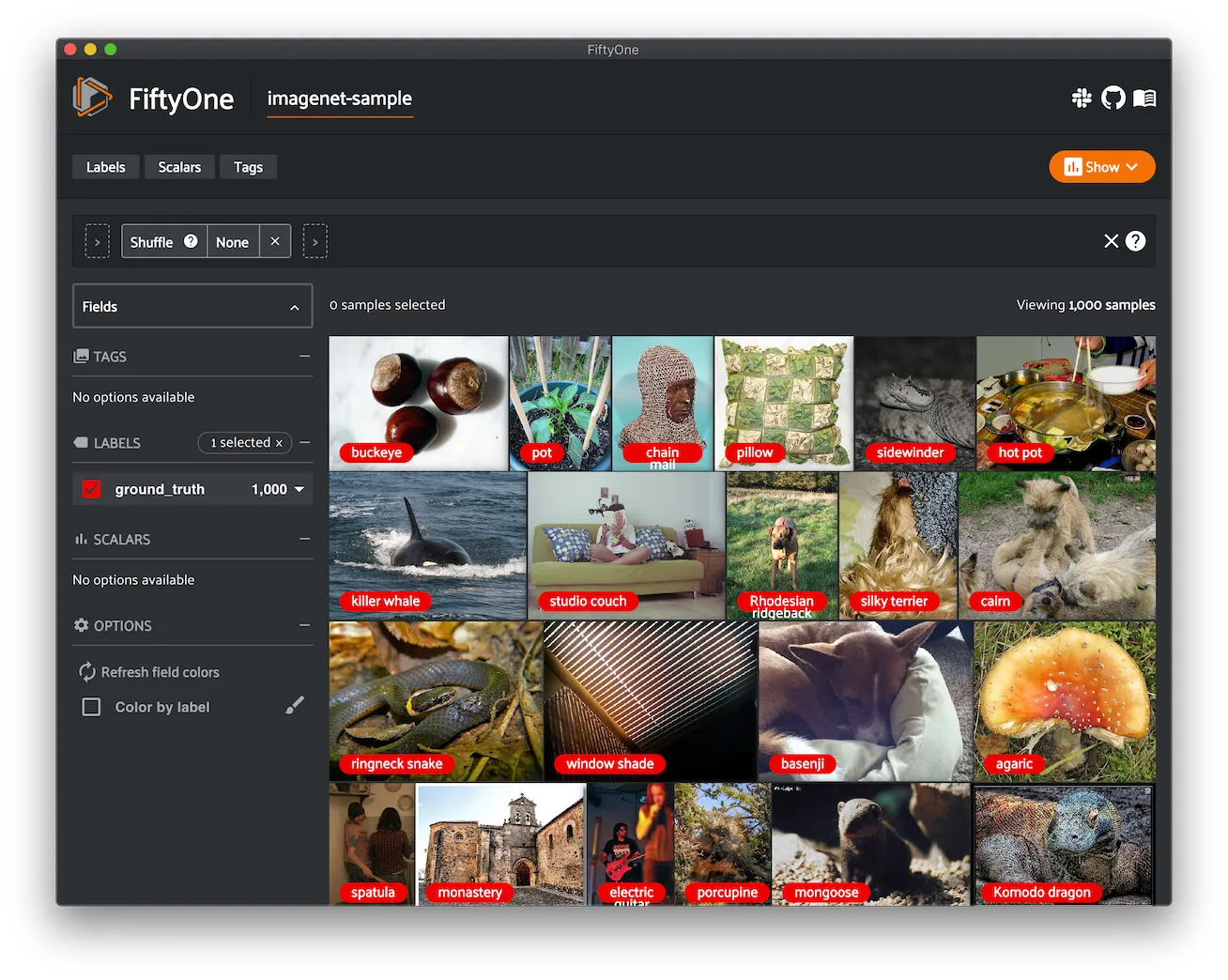
Kinetics 400 ¶¶
Kinetics is a collection of large-scale, high-quality datasets of URL links of up to 650,000 video clips that cover 400/600/700 human action classes, depending on the dataset version. The videos include human-object interactions such as playing instruments, as well as human-human interactions such as shaking hands and hugging. Each action class has at least 400/600/700 video clips. Each clip is human annotated with a single action class and lasts around 10 seconds.
This dataset contains videos and action classifications for the 400 class version of the dataset.
Details
-
Dataset name:
kinetics-400 -
Dataset source: https://deepmind.com/research/open-source/kinetics
-
Dataset size: 456 GB
-
Tags:
video, classification, action-recognition -
Supported splits:
train, test, validation -
ZooDataset class:
Kinetics400Dataset
Original split stats:
-
Train split: 219,782 videos
-
Test split: 35,357 videos
-
Validation split: 18,035 videos
CVDF split stats:
-
Train split: 246,534 videos
-
Test split: 39,805 videos
-
Validation split: 19,906 videos
Dataset size:
-
Train split: 370 GB
-
Test split: 56 GB
-
Validation split: 30 GB
Partial downloads
Kinetics is a massive dataset, so FiftyOne provides parameters that can be used to efficiently download specific subsets of the dataset to suit your needs. When new subsets are specified, FiftyOne will use existing downloaded data first if possible before resorting to downloading additional data from the web.
Kinetics videos were originally only accessible from YouTube. Over time, some videos have become unavailable so the CVDF have hosted the Kinetics dataset on AWS.
If you are partially downloading the dataset through FiftyOne, the specific videos of interest will be downloaded from YouTube, if necessary. However, when you load an entire split, the CVDF-provided files will be downloaded from AWS.
The following parameters are available to configure a partial download of
Kinetics by passing them to
load_zoo_dataset():
-
split ( None) and splits ( None): a string or list of strings, respectively, specifying the splits to load. Supported values are
("train", "test", "validation"). If neither is provided, all available splits are loaded -
classes ( None): a string or list of strings specifying required classes to load. If provided, only samples containing at least one instance of a specified class will be loaded
-
num_workers ( None): the number of processes to use when downloading individual videos. By default,
multiprocessing.cpu_count()is used -
shuffle ( False): whether to randomly shuffle the order in which samples are chosen for partial downloads
-
seed ( None): a random seed to use when shuffling
-
max_samples ( None): a maximum number of samples to load per split. If
classesare also specified, only up to the number of samples that contain at least one specified class will be loaded. By default, all matching samples are loaded
Note
Unlike other versions, Kinteics 400 does not have zips available by class
so whenever either classes or max_samples is provided, videos will be
downloaded from YouTube.
Example usage
Note
In order to work with video datasets, you’ll need to have ffmpeg installed.
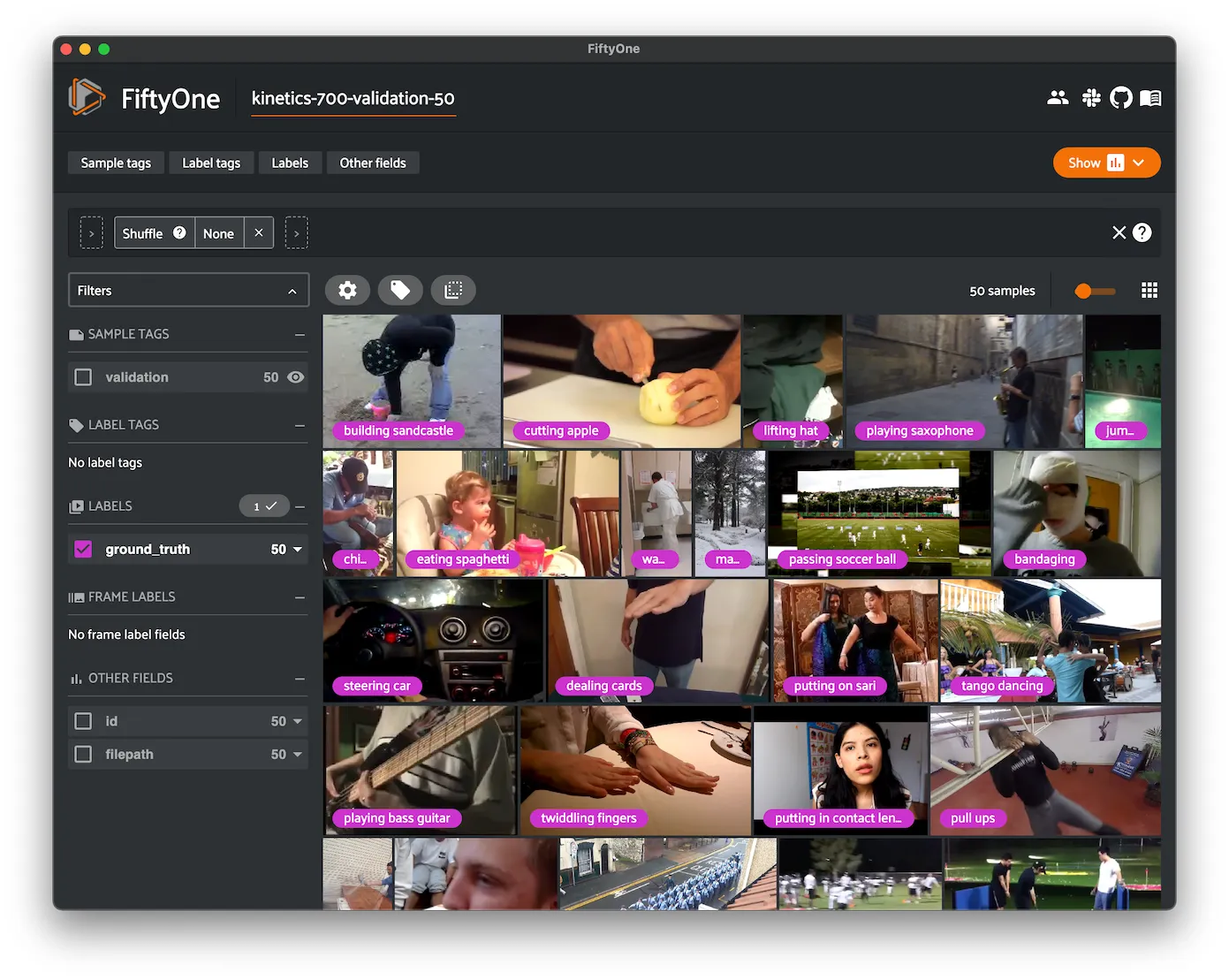
Kinetics 600 ¶¶
Kinetics is a collection of large-scale, high-quality datasets of URL links of up to 650,000 video clips that cover 400/600/700 human action classes, depending on the dataset version. The videos include human-object interactions such as playing instruments, as well as human-human interactions such as shaking hands and hugging. Each action class has at least 400/600/700 video clips. Each clip is human annotated with a single action class and lasts around 10 seconds.
This dataset contains videos and action classifications for the 600 class version of the dataset.
Details
-
Dataset name:
kinetics-600 -
Dataset source: https://deepmind.com/research/open-source/kinetics
-
Dataset size: 779 GB
-
Tags:
video, classification, action-recognition -
Supported splits:
train, test, validation -
ZooDataset class:
Kinetics600Dataset
Original split stats:
-
Train split: 370,582 videos
-
Test split: 56,618 videos
-
Validation split: 28,313 videos
CVDF split stats:
-
Train split: 427,549 videos
-
Test split: 72,924 videos
-
Validation split: 29,793 videos
Dataset size:
-
Train split: 648 GB
-
Test split: 88 GB
-
Validation split: 43 GB
Partial downloads
Kinetics is a massive dataset, so FiftyOne provides parameters that can be used to efficiently download specific subsets of the dataset to suit your needs. When new subsets are specified, FiftyOne will use existing downloaded data first if possible before resorting to downloading additional data from the web.
Kinetics videos were originally only accessible from YouTube. Over time, some videos have become unavailable so the CVDF have hosted the Kinetics dataset on AWS.
If you are partially downloading the dataset through FiftyOne, the specific videos of interest will be downloaded from YouTube, if necessary. However, when you load an entire split, the CVDF-provided files will be downloaded from AWS.
The following parameters are available to configure a partial download of
Kinetics by passing them to
load_zoo_dataset():
-
split ( None) and splits ( None): a string or list of strings, respectively, specifying the splits to load. Supported values are
("train", "test", "validation"). If neither is provided, all available splits are loaded -
classes ( None): a string or list of strings specifying required classes to load. If provided, only samples containing at least one instance of a specified class will be loaded
-
num_workers ( None): the number of processes to use when downloading individual videos. By default,
multiprocessing.cpu_count()is used -
shuffle ( False): whether to randomly shuffle the order in which samples are chosen for partial downloads
-
seed ( None): a random seed to use when shuffling
-
max_samples ( None): a maximum number of samples to load per split. If
classesare also specified, only up to the number of samples that contain at least one specified class will be loaded. By default, all matching samples are loaded
Example usage
Note
In order to work with video datasets, you’ll need to have ffmpeg installed.

Kinetics 700 ¶¶
Kinetics is a collection of large-scale, high-quality datasets of URL links of up to 650,000 video clips that cover 400/600/700 human action classes, depending on the dataset version. The videos include human-object interactions such as playing instruments, as well as human-human interactions such as shaking hands and hugging. Each action class has at least 400/600/700 video clips. Each clip is human annotated with a single action class and lasts around 10 seconds.
This dataset contains videos and action classifications for the 700 class version of the dataset.
Details
-
Dataset name:
kinetics-700 -
Dataset source: https://deepmind.com/research/open-source/kinetics
-
Dataset size: 710 GB
-
Tags:
video, classification, action-recognition -
Supported splits:
train, test, validation -
ZooDataset class:
Kinetics700Dataset
Split stats:
-
Train split: 529,046 videos
-
Test split: 67,446 videos
-
Validation split: 33,925 videos
Dataset size
-
Train split: 603 GB
-
Test split: 59 GB
-
Validation split: 48 GB
Partial downloads
Kinetics is a massive dataset, so FiftyOne provides parameters that can be used to efficiently download specific subsets of the dataset to suit your needs. When new subsets are specified, FiftyOne will use existing downloaded data first if possible before resorting to downloading additional data from the web.
Kinetics videos were originally only accessible from YouTube. Over time, some videos have become unavailable so the CVDF have hosted the Kinetics dataset on AWS.
If you are partially downloading the dataset through FiftyOne, the specific videos of interest will be downloaded from YouTube, if necessary. However, when you load an entire split, the CVDF-provided files will be downloaded from AWS.
The following parameters are available to configure a partial download of
Kinetics by passing them to
load_zoo_dataset():
-
split ( None) and splits ( None): a string or list of strings, respectively, specifying the splits to load. Supported values are
("train", "test", "validation"). If neither is provided, all available splits are loaded -
classes ( None): a string or list of strings specifying required classes to load. If provided, only samples containing at least one instance of a specified class will be loaded
-
num_workers ( None): the number of processes to use when downloading individual videos. By default,
multiprocessing.cpu_count()is used -
shuffle ( False): whether to randomly shuffle the order in which samples are chosen for partial downloads
-
seed ( None): a random seed to use when shuffling
-
max_samples ( None): a maximum number of samples to load per split. If
classesare also specified, only up to the number of samples that contain at least one specified class will be loaded. By default, all matching samples are loaded
Example usage
Note
In order to work with video datasets, you’ll need to have ffmpeg installed.

Kinetics 700-2020 ¶¶
Kinetics is a collection of large-scale, high-quality datasets of URL links of up to 650,000 video clips that cover 400/600/700 human action classes, depending on the dataset version. The videos include human-object interactions such as playing instruments, as well as human-human interactions such as shaking hands and hugging. Each action class has at least 400/600/700 video clips. Each clip is human annotated with a single action class and lasts around 10 seconds.
This version contains videos and action classifications for the 700 class version of the dataset that was updated with new videos in 2020. This dataset is a superset of Kinetics 700.
Details
-
Dataset name:
kinetics-700-2020 -
Dataset source: https://deepmind.com/research/open-source/kinetics
-
Dataset size: 710 GB
-
Tags:
video, classification, action-recognition -
Supported splits:
train, test, validation -
ZooDataset class:
Kinetics7002020Dataset
Original split stats:
-
Train split: 542,352 videos
-
Test split: 67,433 videos
-
Validation split: 34,125 videos
CVDF split stats:
-
Train split: 534,073 videos
-
Test split: 64,260 videos
-
Validation split: 33,914 videos
Dataset size
-
Train split: 603 GB
-
Test split: 59 GB
-
Validation split: 48 GB
Partial downloads
Kinetics is a massive dataset, so FiftyOne provides parameters that can be used to efficiently download specific subsets of the dataset to suit your needs. When new subsets are specified, FiftyOne will use existing downloaded data first if possible before resorting to downloading additional data from the web.
Kinetics videos were originally only accessible from YouTube. Over time, some videos have become unavailable so the CVDF have hosted the Kinetics dataset on AWS.
If you are partially downloading the dataset through FiftyOne, the specific videos of interest will be downloaded from YouTube, if necessary. However, when you load an entire split, the CVDF-provided files will be downloaded from AWS.
The following parameters are available to configure a partial download of
Kinetics by passing them to
load_zoo_dataset():
-
split ( None) and splits ( None): a string or list of strings, respectively, specifying the splits to load. Supported values are
("train", "test", "validation"). If neither is provided, all available splits are loaded -
classes ( None): a string or list of strings specifying required classes to load. If provided, only samples containing at least one instance of a specified class will be loaded
-
num_workers ( None): the number of processes to use when downloading individual videos. By default,
multiprocessing.cpu_count()is used -
shuffle ( False): whether to randomly shuffle the order in which samples are chosen for partial downloads
-
seed ( None): a random seed to use when shuffling
-
max_samples ( None): a maximum number of samples to load per split. If
classesare also specified, only up to the number of samples that contain at least one specified class will be loaded. By default, all matching samples are loaded
Example usage
Note
In order to work with video datasets, you’ll need to have ffmpeg installed.

KITTI ¶¶
KITTI contains a suite of vision tasks built using an autonomous driving platform.
This dataset contains the left camera images and the associated 2D object detections.
The training split contains 7,481 annotated images, and the test split contains 7,518 unlabeled images.
A full description of the annotations can be found in the README of the object development kit on the KITTI homepage.
Details
-
Dataset name:
kitti -
Dataset source: http://www.cvlibs.net/datasets/kitti
-
Dataset size: 12.57 GB
-
Tags:
image, detection -
Supported splits:
train, test -
ZooDataset class:
KITTIDataset
Example usage
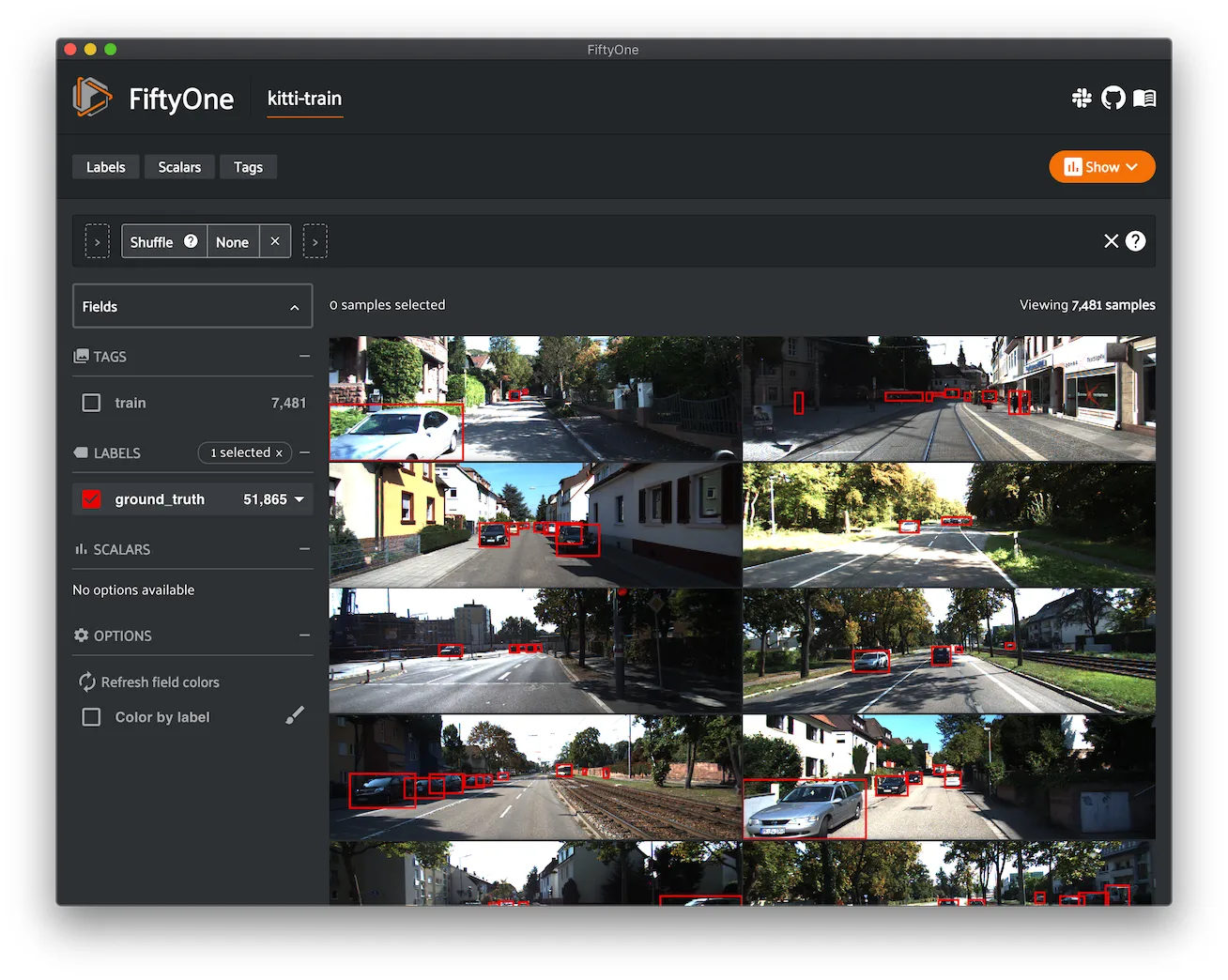
KITTI Multiview ¶¶
KITTI contains a suite of vision tasks built using an autonomous driving platform.
This dataset contains the following multiview data for each scene:
-
Left camera images annotated with 2D object detections
-
Right camera images annotated with 2D object detections
-
Velodyne LIDAR point clouds annotated with 3D object detections
The training split contains 7,481 annotated scenes, and the test split contains 7,518 unlabeled scenes.
A full description of the annotations can be found in the README of the object development kit on the KITTI homepage.
Details
-
Dataset name:
kitti-multiview -
Dataset source: http://www.cvlibs.net/datasets/kitti
-
Dataset size: 53.34 GB
-
Tags:
image, point-cloud, detection -
Supported splits:
train, test -
ZooDataset class:
KITTIMultiviewDataset
Example usage
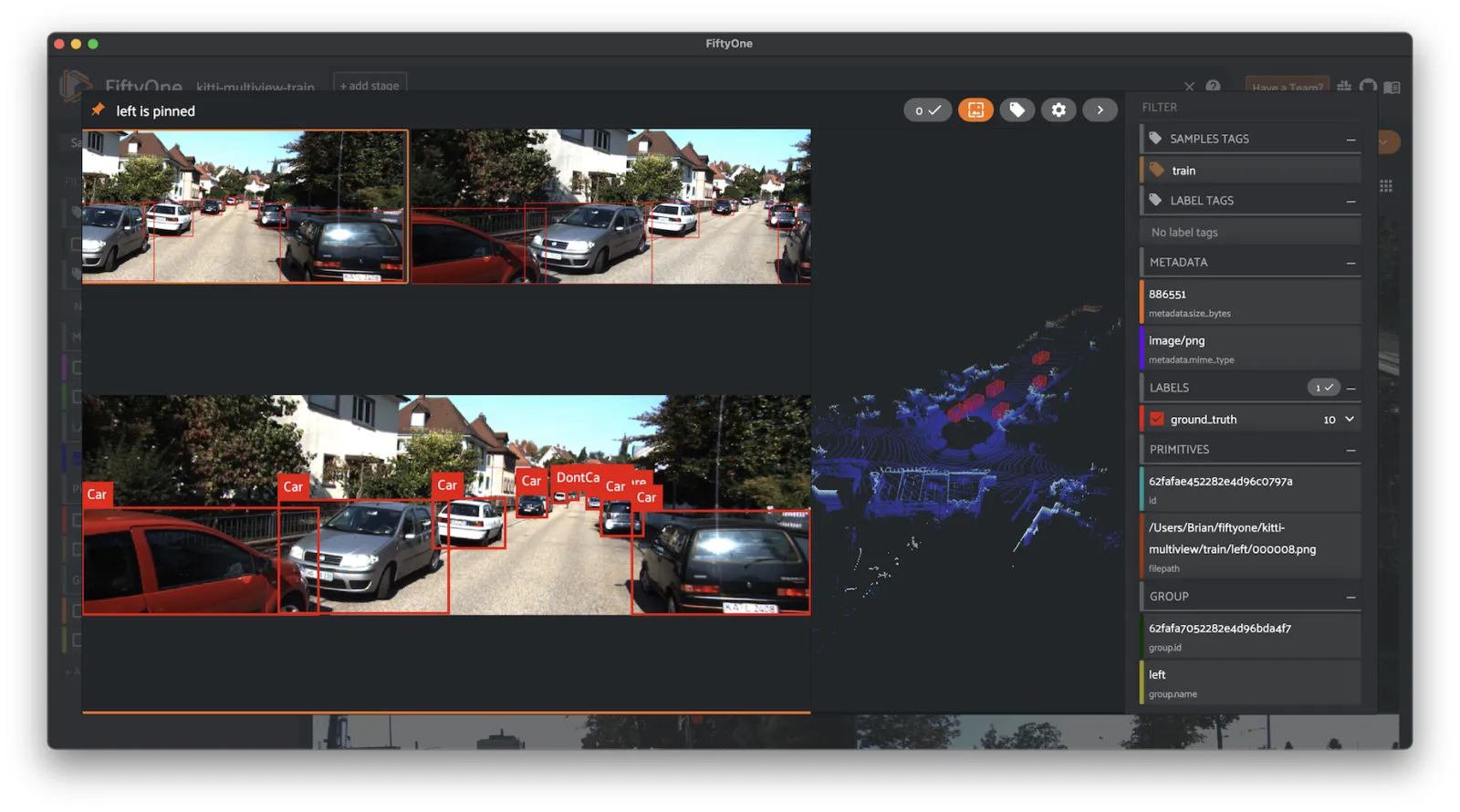
Labeled Faces in the Wild ¶¶
Labeled Faces in the Wild is a public benchmark for face verification, also known as pair matching.
The dataset contains 13,233 images of 5,749 people’s faces collected from the web. Each face has been labeled with the name of the person pictured. 1,680 of the people pictured have two or more distinct photos in the data set. The only constraint on these faces is that they were detected by the Viola-Jones face detector.
Details
-
Dataset name:
lfw -
Dataset source: http://vis-www.cs.umass.edu/lfw
-
Dataset size: 173.00 MB
-
Tags:
image, classification, facial-recognition -
Supported splits:
test, train -
ZooDataset class:
LabeledFacesInTheWildDataset
Example usage
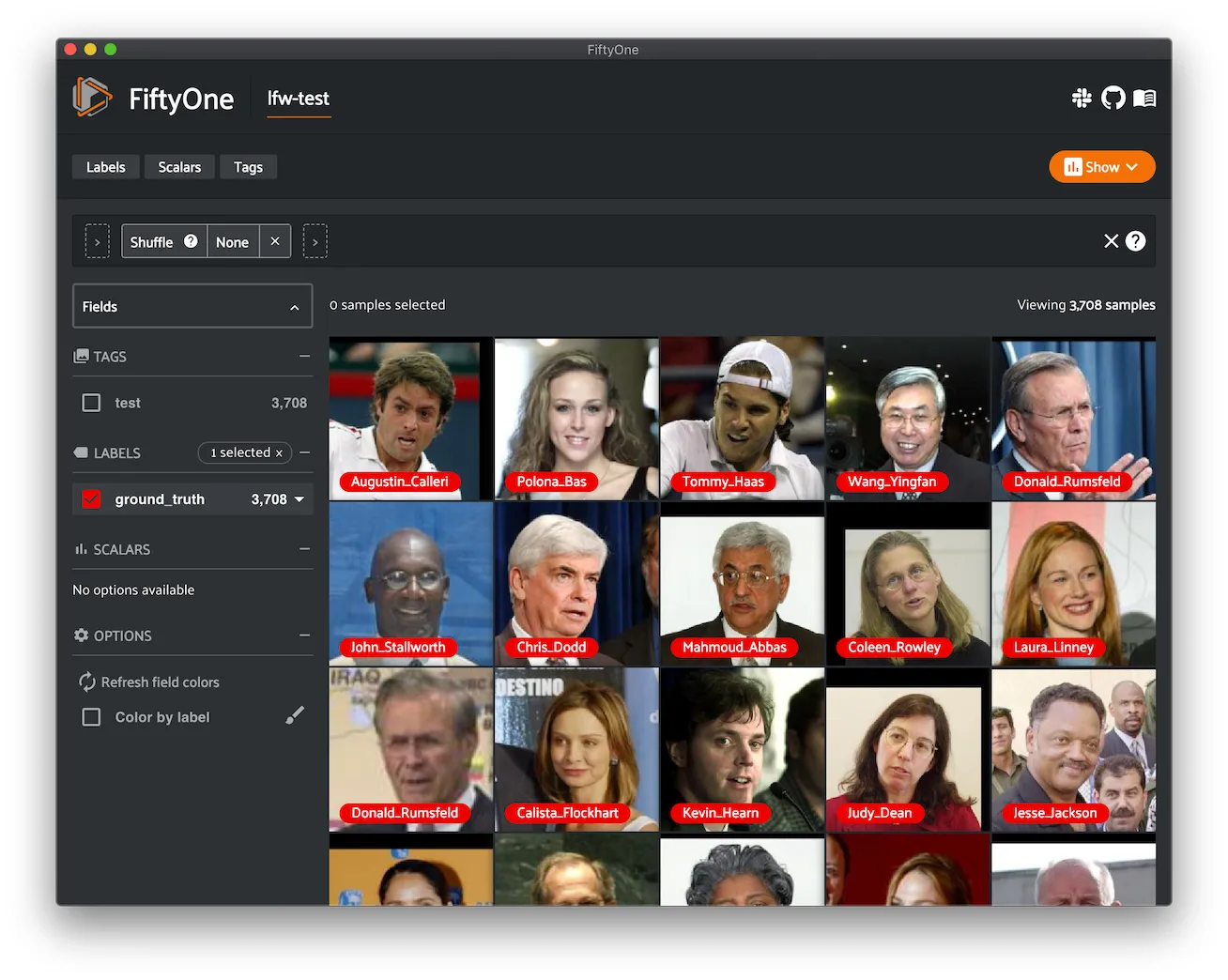
MNIST ¶¶
The MNIST database of handwritten digits.
The dataset consists of 70,000 28 x 28 grayscale images in 10 classes. There are 60,000 training images and 10,000 test images.
Details
-
Dataset name:
mnist -
Dataset source: http://yann.lecun.com/exdb/mnist
-
Dataset size: 21.00 MB
-
Tags:
image, classification -
Supported splits:
train, test -
ZooDataset classes:
-
MNISTDataset(TF backend) -
MNISTDataset(Torch backend)
Note
You must have the Torch or TensorFlow backend(s) installed to load this dataset.
Example usage
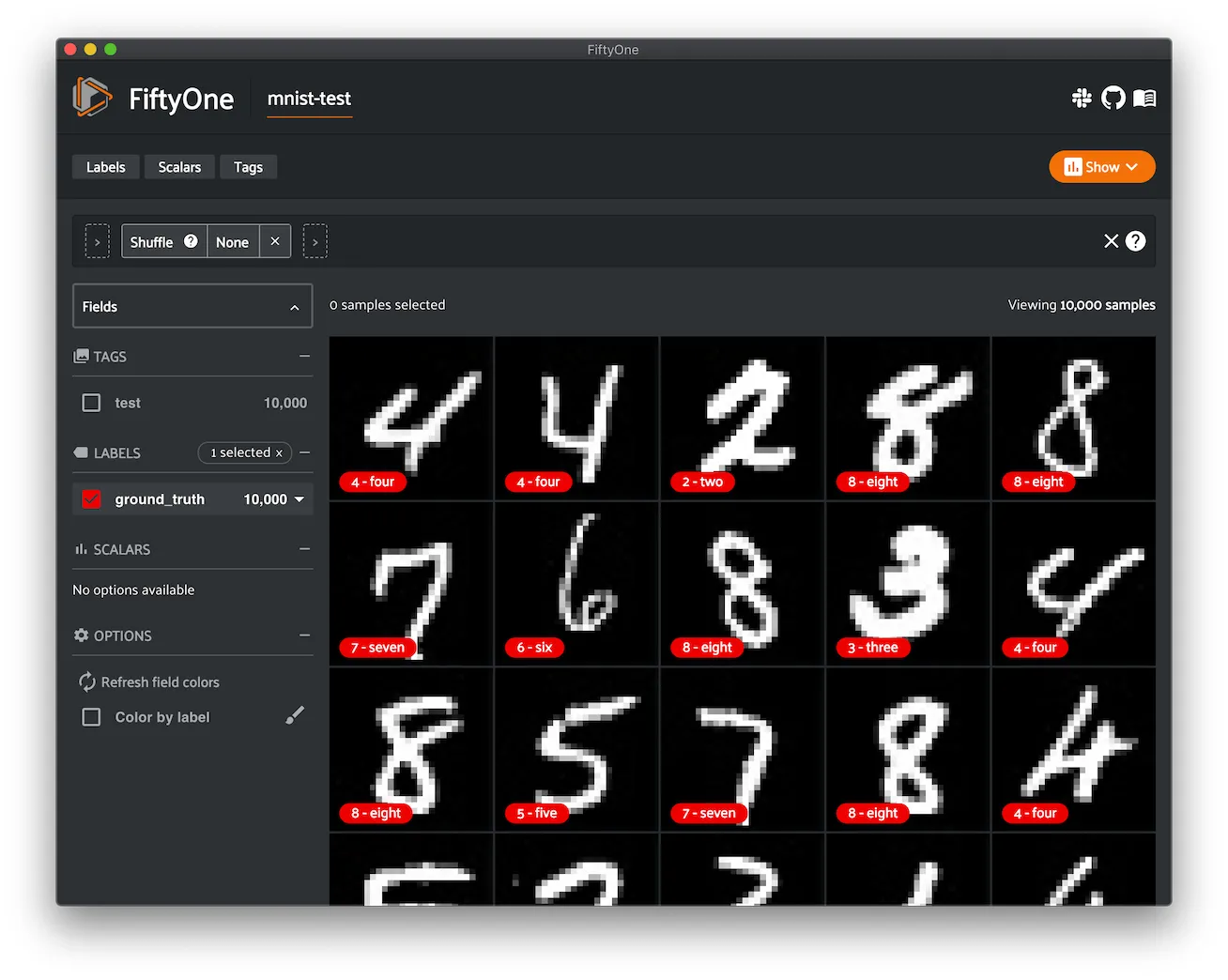
Open Images V6 ¶¶
Open Images V6 is a dataset of ~9 million images, roughly 2 million of which are annotated and available via this zoo dataset.
The dataset contains annotations for classification, detection, segmentation, and visual relationship tasks for the 600 boxable classes.
Note
We’ve collaborated with the Open Images Team at Google to make FiftyOne a recommended tool for downloading, visualizing, and evaluating on the Open Images Dataset!
Check out this guide for more details on using FiftyOne to work with Open Images.
Details
-
Dataset name:
open-images-v6 -
Dataset source: https://storage.googleapis.com/openimages/web/index.html
-
Dataset size: 561 GB
-
Tags:
image, detection, segmentation, classification -
Supported splits:
train, test, validation -
ZooDataset class:
OpenImagesV6Dataset
Notes
-
Not all images contain all types of labels
-
All images have been rescaled so that their largest side is at most 1024 pixels
Full split stats
-
Train split: 1,743,042 images (513 GB)
-
Test split: 125,436 images (36 GB)
-
Validation split: 41,620 images (12 GB)
Partial downloads
Open Images is a massive dataset, so FiftyOne provides parameters that can be used to efficiently download specific subsets of the dataset to suit your needs. When new subsets are specified, FiftyOne will use existing downloaded data first if possible before resorting to downloading additional data from the web.
The following parameters are available to configure a partial download of Open
Images V6 by passing them to
load_zoo_dataset():
-
split ( None) and splits ( None): a string or list of strings, respectively, specifying the splits to load. Supported values are
("train", "test", "validation"). If neither is provided, all available splits are loaded -
label_types ( None): a label type or list of label types to load. Supported values are
("detections", "classifications", "relationships", "segmentations"). By default, all labels types are loaded -
classes ( None): a string or list of strings specifying required classes to load. If provided, only samples containing at least one instance of a specified class will be loaded. You can use
get_classes()andget_segmentation_classes()to see the available classes and segmentation classes, respectively -
attrs ( None): a string or list of strings specifying required relationship attributes to load. This parameter is only applicable if
label_typescontains"relationships". If provided, only samples containing at least one instance of a specified attribute will be loaded. You can useget_attributes()to see the available attributes -
image_ids ( None): a list of specific image IDs to load. The IDs can be specified either as
<split>/<image-id>or<image-id>strings. Alternatively, you can provide the path to a TXT (newline-separated), JSON, or CSV file containing the list of image IDs to load in either of the first two formats -
include_id ( True): whether to include the Open Images ID of each sample in the loaded labels
-
only_matching ( False): whether to only load labels that match the
classesorattrsrequirements that you provide (True), or to load all labels for samples that match the requirements (False) -
num_workers ( None): the number of processes to use when downloading individual images. By default,
multiprocessing.cpu_count()is used -
shuffle ( False): whether to randomly shuffle the order in which samples are chosen for partial downloads
-
seed ( None): a random seed to use when shuffling
-
max_samples ( None): a maximum number of samples to load per split. If
label_types,classes, and/orattrsare also specified, first priority will be given to samples that contain all of the specified label types, classes, and/or attributes, followed by samples that contain at least one of the specified labels types or classes. The actual number of samples loaded may be less than this maximum value if the dataset does not contain sufficient samples matching your requirements
Note
See
OpenImagesV6Dataset
and OpenImagesV6DatasetImporter
for complete descriptions of the optional keyword arguments that you can
pass to load_zoo_dataset().
Example usage
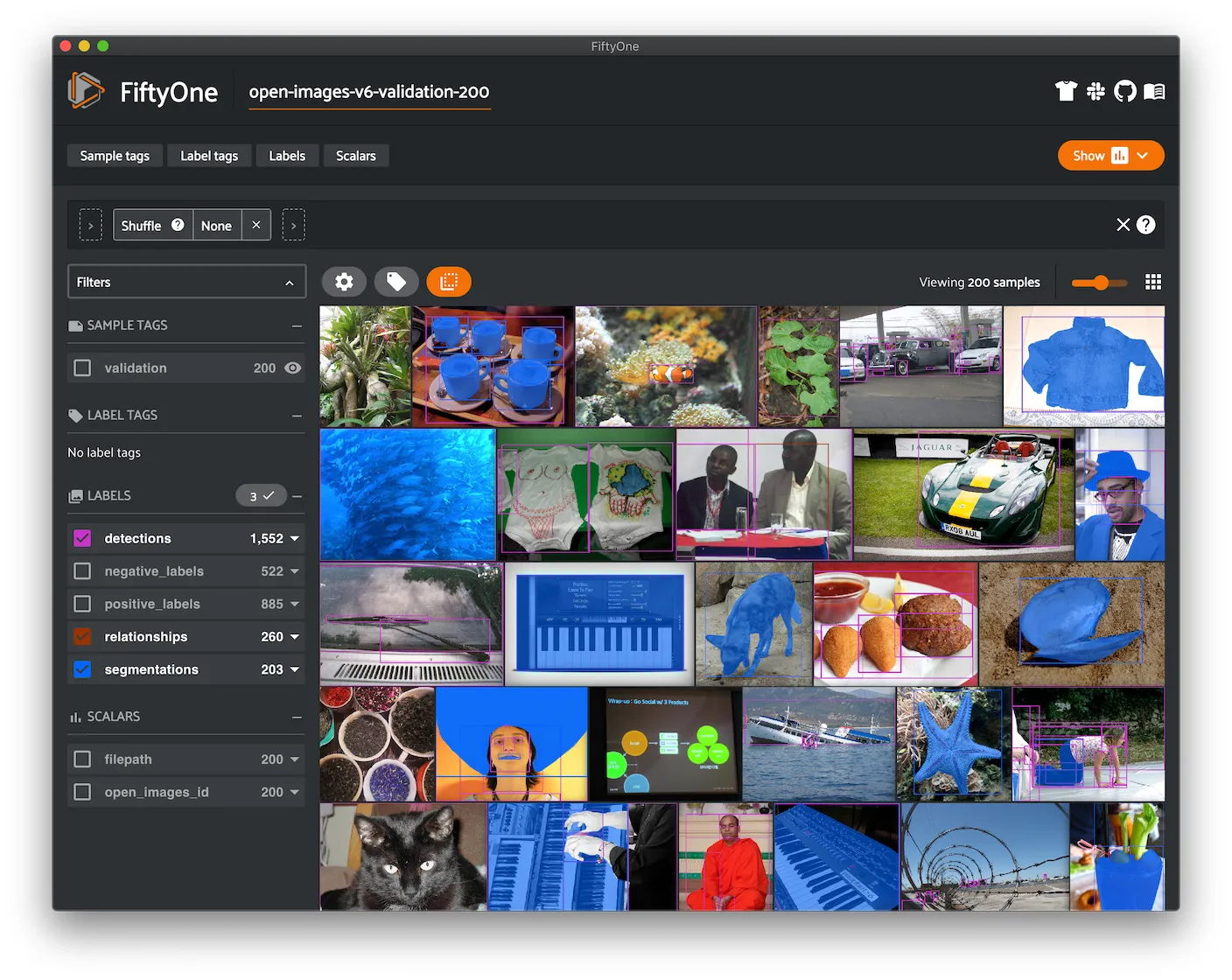
Open Images V7 ¶¶
Open Images V7 is a dataset of ~9 million images, roughly 2 million of which are annotated and available via this zoo dataset.
The dataset contains annotations for classification, detection, segmentation, keypoints, and visual relationship tasks for the 600 boxable classes.
Note
We’ve collaborated with the Open Images Team at Google to make FiftyOne a recommended tool for downloading, visualizing, and evaluating on the Open Images Dataset!
Check out this guide for more details on using FiftyOne to work with Open Images.
Details
-
Dataset name:
open-images-v7 -
Dataset source: https://storage.googleapis.com/openimages/web/index.html
-
Dataset size: 561 GB
-
Tags:
image, detection, segmentation, classification, keypoint -
Supported splits:
train, test, validation -
ZooDataset class:
OpenImagesV7Dataset
Notes
-
Not all images contain all types of labels
-
All images have been rescaled so that their largest side is at most 1024 pixels
Full split stats
-
Train split: 1,743,042 images (513 GB)
-
Test split: 125,436 images (36 GB)
-
Validation split: 41,620 images (12 GB)
Partial downloads
Open Images is a massive dataset, so FiftyOne provides parameters that can be used to efficiently download specific subsets of the dataset to suit your needs. When new subsets are specified, FiftyOne will use existing downloaded data first if possible before resorting to downloading additional data from the web.
The following parameters are available to configure a partial download of Open
Images V7 by passing them to
load_zoo_dataset():
-
split ( None) and splits ( None): a string or list of strings, respectively, specifying the splits to load. Supported values are
("train", "test", "validation"). If neither is provided, all available splits are loaded -
label_types ( None): a label type or list of label types to load. Supported values are
("detections", "classifications", "relationships", "points", segmentations"). By default, all labels types are loaded -
classes ( None): a string or list of strings specifying required classes to load. If provided, only samples containing at least one instance of a specified class will be loaded. You can use
get_classes()andget_segmentation_classes()to see the available classes and segmentation classes, respectively -
attrs ( None): a string or list of strings specifying required relationship attributes to load. This parameter is only applicable if
label_typescontains"relationships". If provided, only samples containing at least one instance of a specified attribute will be loaded. You can useget_attributes()to see the available attributes -
image_ids ( None): a list of specific image IDs to load. The IDs can be specified either as
<split>/<image-id>or<image-id>strings. Alternatively, you can provide the path to a TXT (newline-separated), JSON, or CSV file containing the list of image IDs to load in either of the first two formats -
include_id ( True): whether to include the Open Images ID of each sample in the loaded labels
-
only_matching ( False): whether to only load labels that match the
classesorattrsrequirements that you provide (True), or to load all labels for samples that match the requirements (False) -
num_workers ( None): the number of processes to use when downloading individual images. By default,
multiprocessing.cpu_count()is used -
shuffle ( False): whether to randomly shuffle the order in which samples are chosen for partial downloads
-
seed ( None): a random seed to use when shuffling
-
max_samples ( None): a maximum number of samples to load per split. If
label_types,classes, and/orattrsare also specified, first priority will be given to samples that contain all of the specified label types, classes, and/or attributes, followed by samples that contain at least one of the specified labels types or classes. The actual number of samples loaded may be less than this maximum value if the dataset does not contain sufficient samples matching your requirements
Note
See
OpenImagesV7Dataset
and OpenImagesV7DatasetImporter
for complete descriptions of the optional keyword arguments that you can
pass to load_zoo_dataset().
Example usage
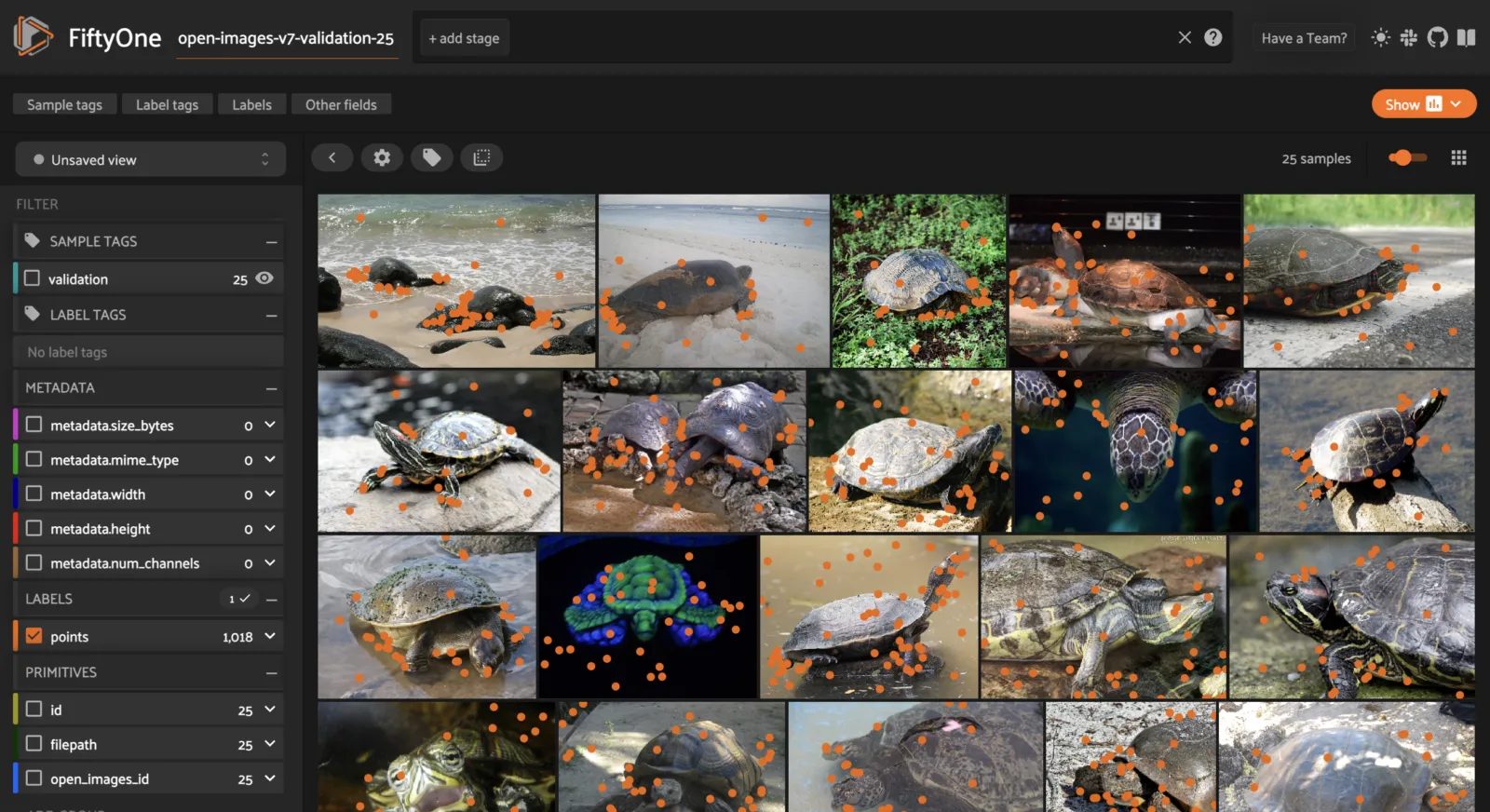
Places ¶¶
Places is a scene recognition dataset of 10 million images comprising ~400 unique scene categories.
The images are labeled with scene semantic categories, comprising a large and diverse list of the types of environments encountered in the world.
Details
-
Dataset name:
places -
Dataset source: http://places2.csail.mit.edu/download-private.html
-
Dataset size: 29 GB
-
Tags:
image, classification -
Supported splits:
train, validation, test -
ZooDataset classes:
PlacesDataset
Full split stats
-
Train split: 1,803,460 images, with between 3,068 and 5,000 per category
-
Test split: 328,500 images, with 900 images per category
-
Validation split: 36,500 images, with 100 images per category
Example usage
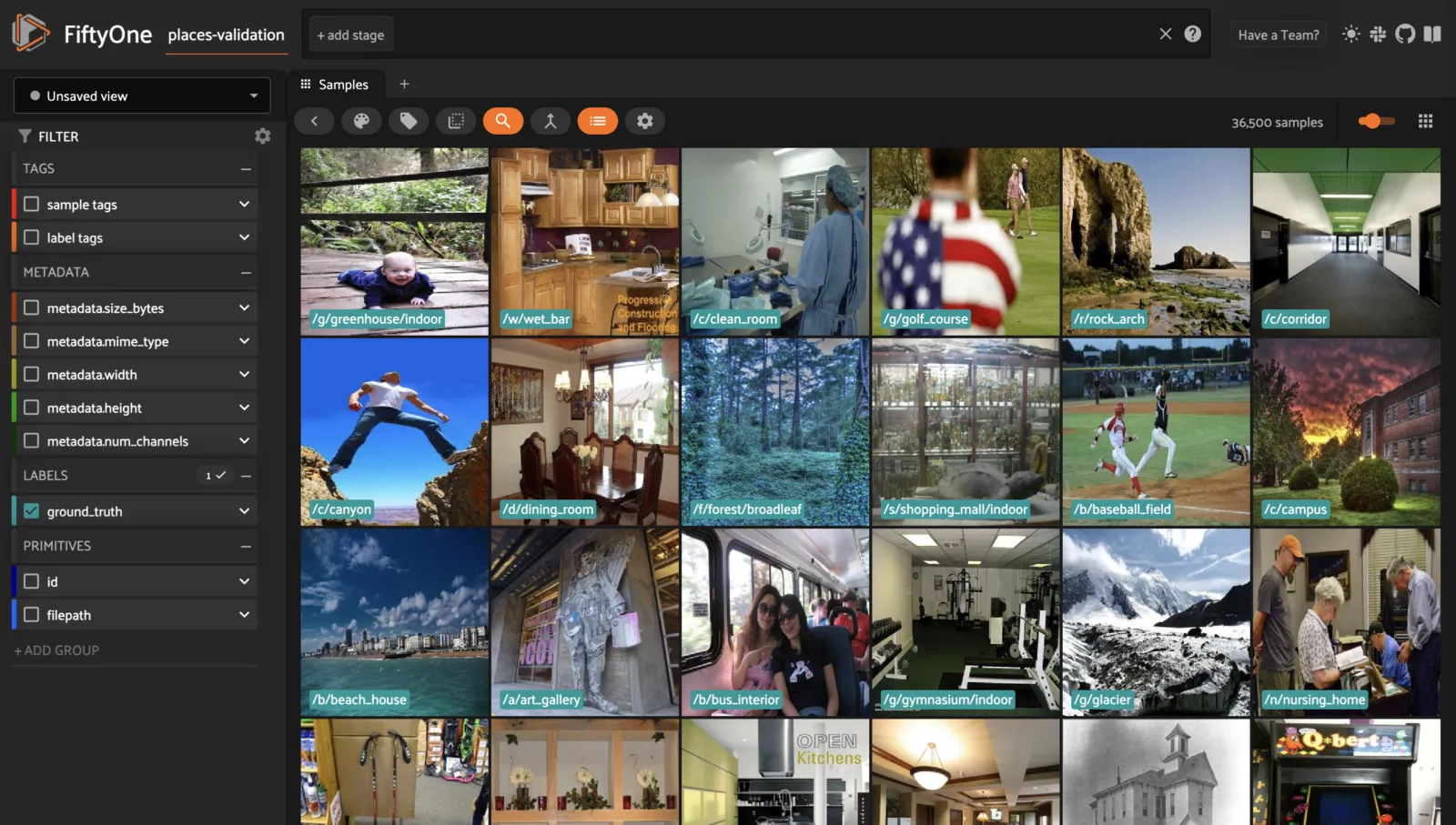
Quickstart ¶¶
A small dataset with ground truth bounding boxes and predictions.
The dataset consists of 200 images from the validation split of COCO-2017, with model predictions generated by an out-of-the-box Faster R-CNN model from torchvision.models.
Details
-
Dataset name:
quickstart -
Dataset size: 23.40 MB
-
Tags:
image, quickstart -
Supported splits:
N/A -
ZooDataset class:
QuickstartDataset
Example usage
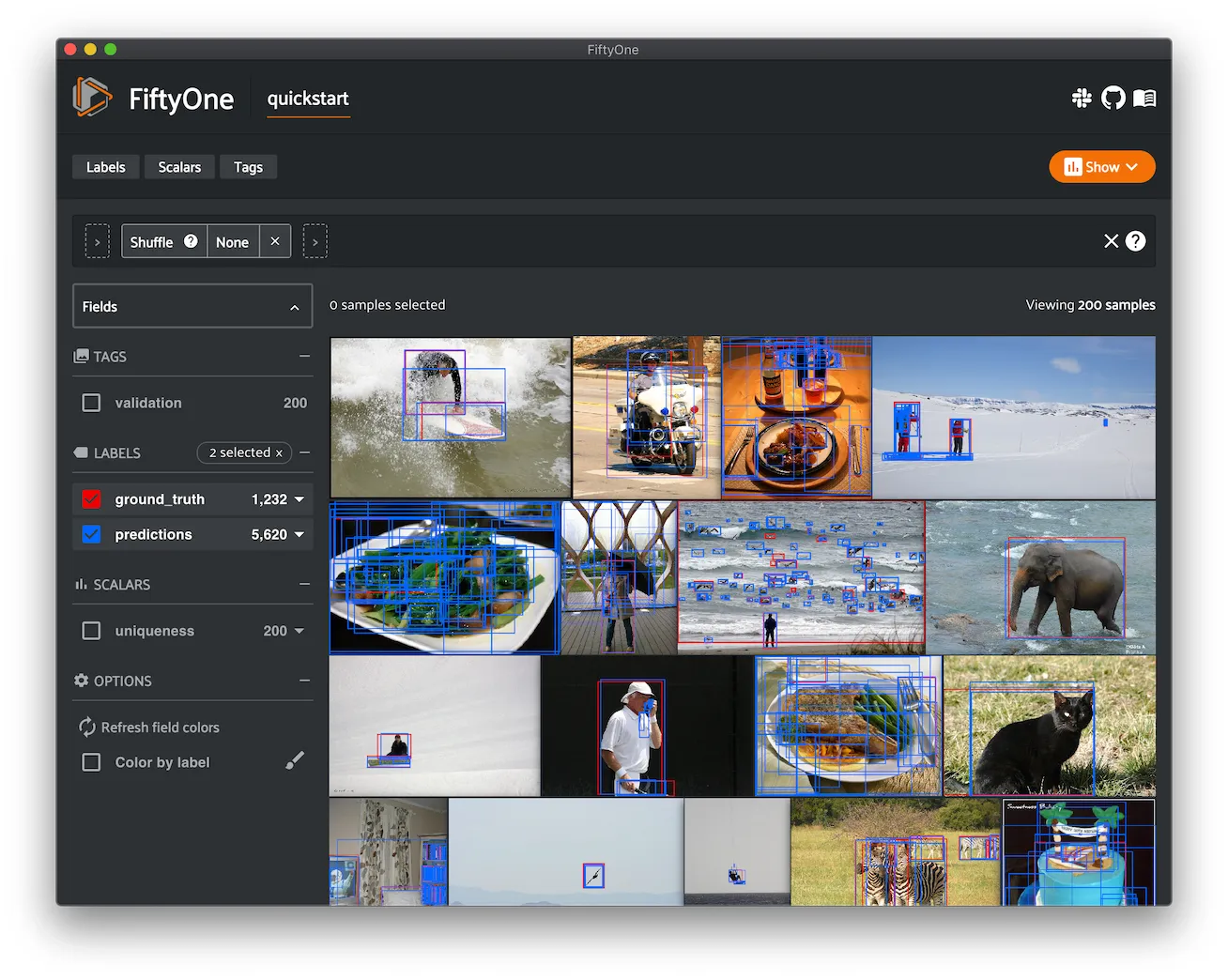
Quickstart Geo ¶¶
A small dataset with geolocation data.
The dataset consists of 500 images from the validation split of the BDD100K dataset in the New York City area with object detections and GPS timestamps.
Details
-
Dataset name:
quickstart-geo -
Dataset size: 33.50 MB
-
Tags:
image, location, quickstart -
Supported splits:
N/A -
ZooDataset class:
QuickstartGeoDataset
Example usage
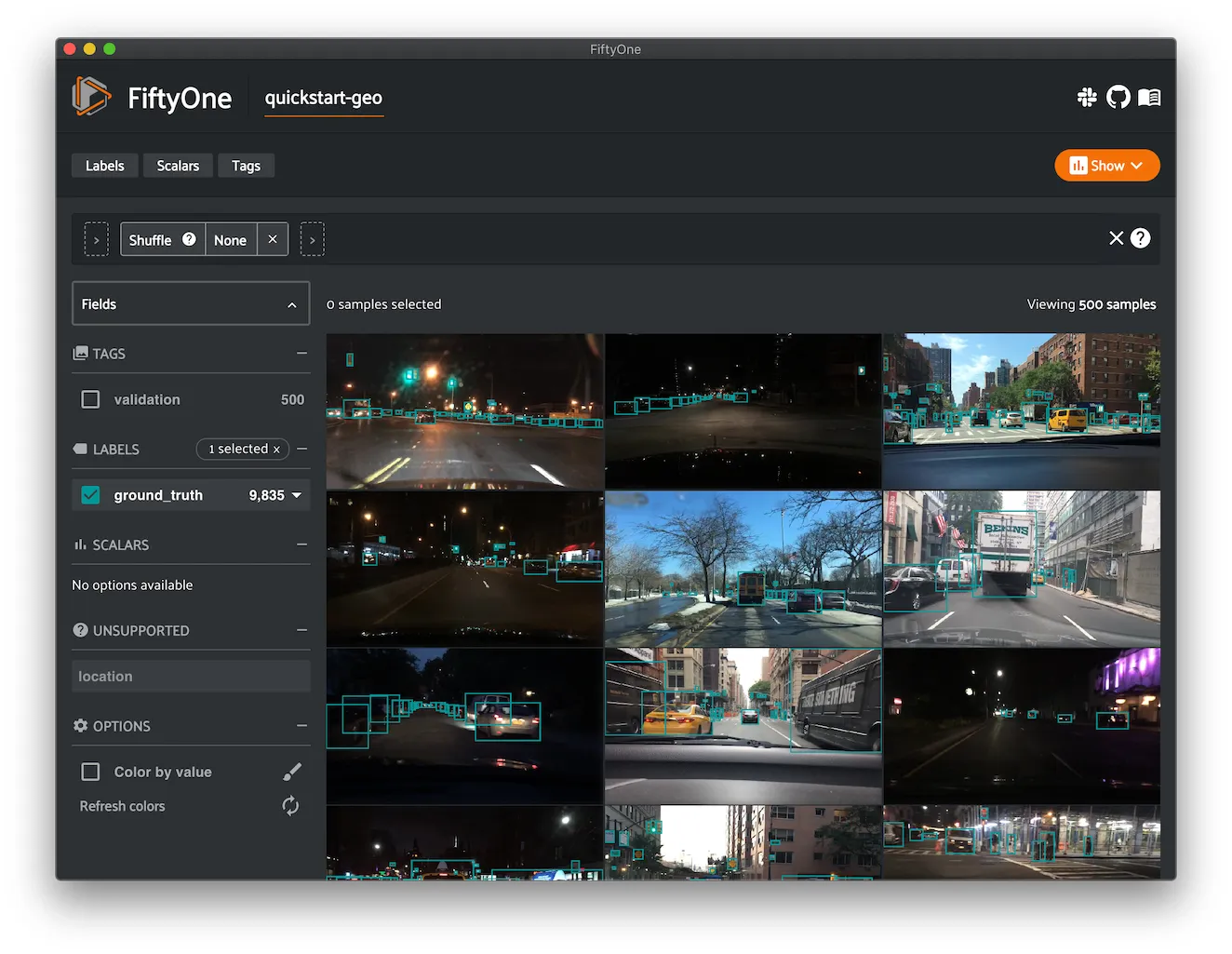
Quickstart Video ¶¶
A small video dataset with dense annotations.
The dataset consists of 10 video segments with dense object detections generated by human annotators.
Details
-
Dataset name:
quickstart-video -
Dataset size: 35.20 MB
-
Tags:
video, quickstart -
Supported splits:
N/A -
ZooDataset class:
QuickstartVideoDataset
Example usage
Note
In order to work with video datasets, you’ll need to have ffmpeg installed.
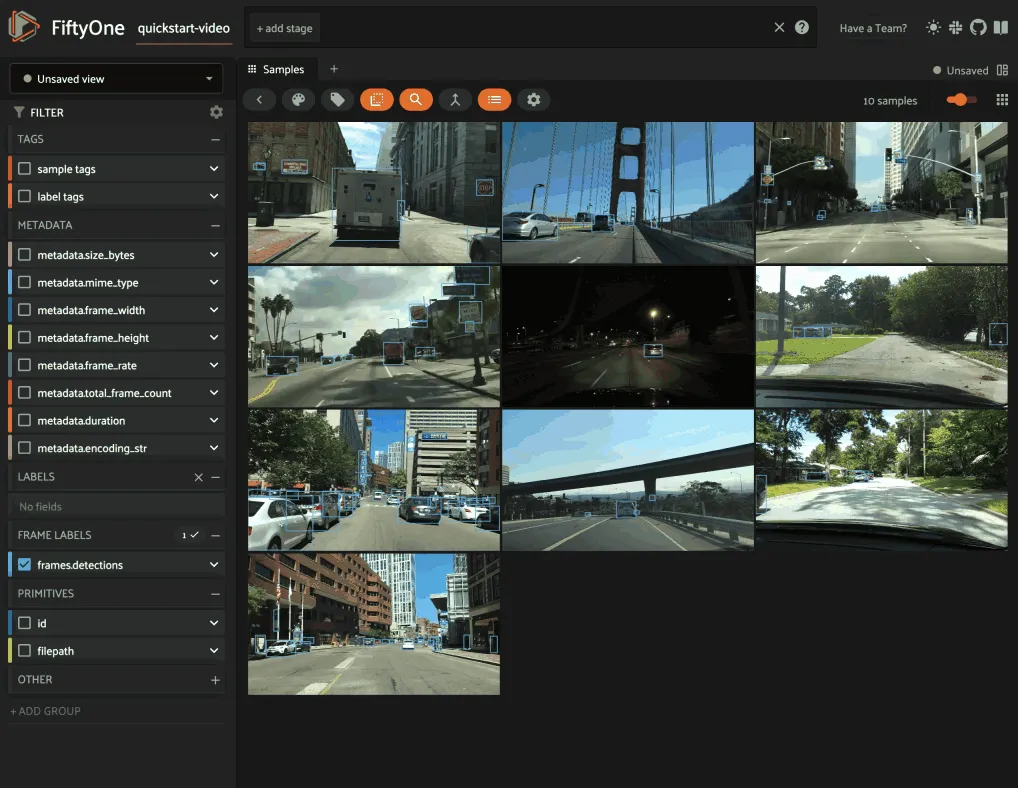
Quickstart Groups ¶¶
A small dataset with grouped image and point cloud data.
The dataset consists of 200 scenes from the train split of the KITTI dataset, each containing left camera, right camera, point cloud, and 2D/3D object annotation data.
Details
-
Dataset name:
quickstart-groups -
Dataset size: 516.3 MB
-
Tags:
image, point-cloud, quickstart -
Supported splits:
N/A -
ZooDataset class:
QuickstartGroupsDataset
Example usage
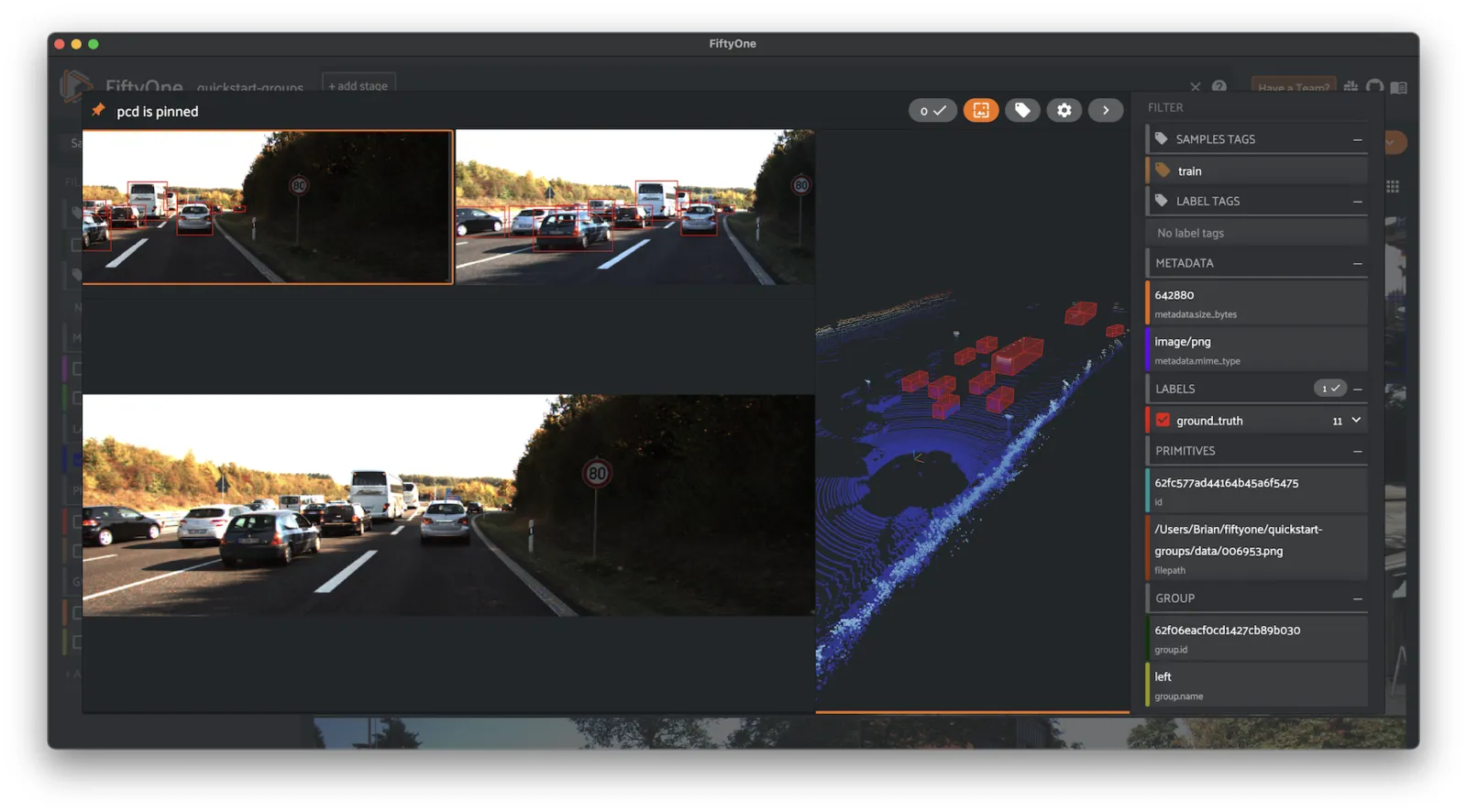
Quickstart 3D ¶¶
A small 3D dataset with meshes, point clouds, and oriented bounding boxes.
The dataset consists of 200 3D mesh samples from the test split of the ModelNet40 dataset, with point clouds generated using a Poisson disk sampling method, and oriented bounding boxes generated based on the convex hull.
Objects have been rescaled and recentered from the original dataset.
Details
-
Dataset name:
quickstart-3d -
Dataset size: 215.7 MB
-
Tags:
3d, point-cloud, mesh, quickstart -
Supported splits:
N/A -
ZooDataset class:
Quickstart3DDataset
Example usage
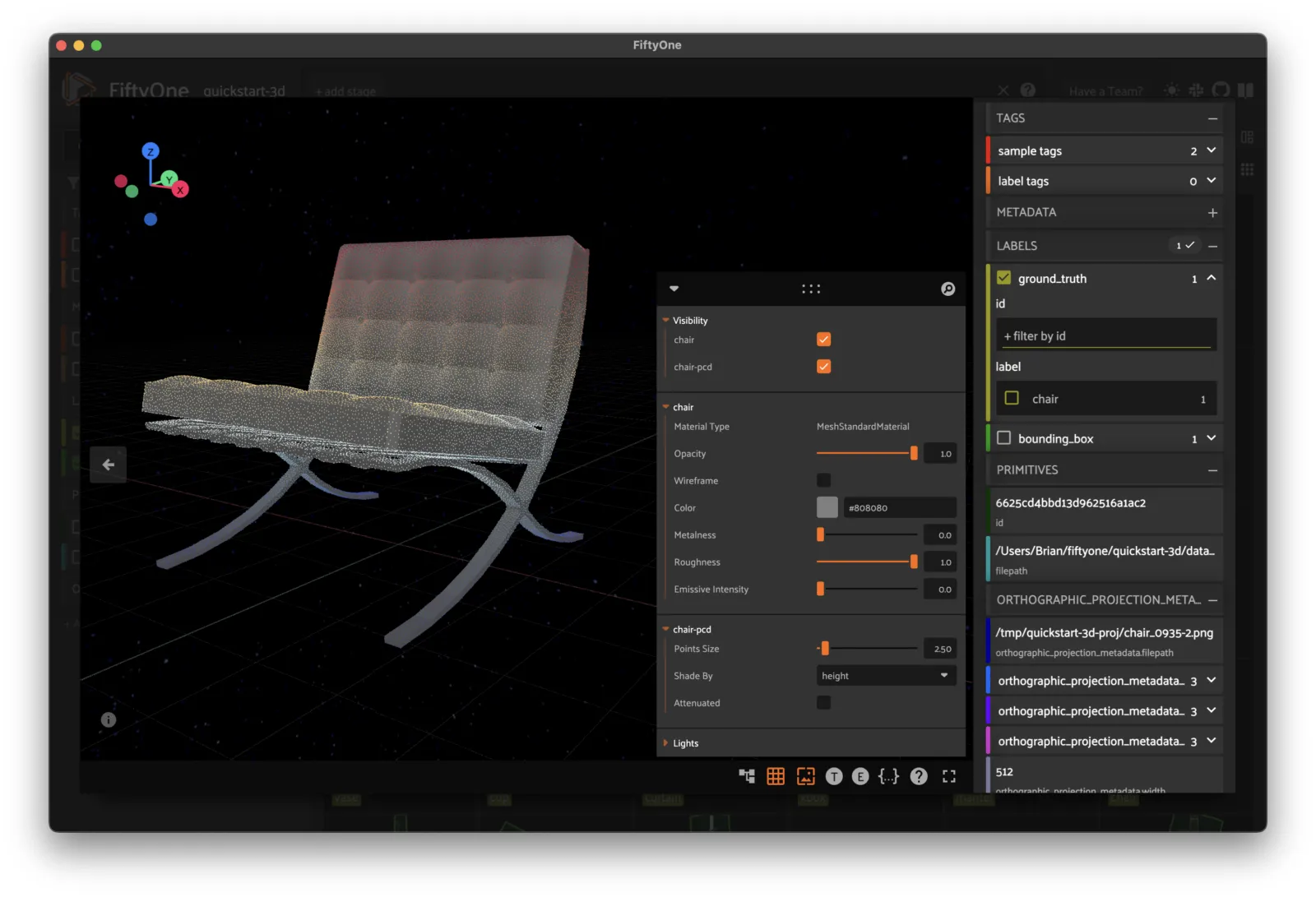
Sama-COCO ¶¶
Sama-COCO is a relabeling of COCO-2017 and is a large-scale object detection and segmentation dataset. Masks in Sama-COCO are tighter and many crowd instances have been decomposed into their components.
This version contains images from the COCO-2017 version of the dataset, as well as annotations in the form of bounding boxes, and segmentation masks provided by Sama.
Notes
-
Sama-COCO defines 91 classes but the data only uses 80 classes (like COCO-2017)
-
Some images from the train and validation sets don’t have annotations
-
The test set does not have annotations
-
Sama-COCO has identical splits to COCO-2017
Details
-
Dataset name:
sama-coco -
Dataset source: https://www.sama.com/sama-coco-dataset/
-
Dataset size: 25.67 GB
-
Tags:
image, detection, segmentation -
Supported splits:
train, validation, test -
ZooDataset class:
SamaCOCODataset
Full split stats
-
Train split: 118,287 images
-
Test split: 40,670 images
-
Validation split: 5,000 images
Partial downloads
FiftyOne provides parameters that can be used to efficiently download specific subsets of the Sama-COCO dataset to suit your needs. When new subsets are specified, FiftyOne will use existing downloaded data first if possible before resorting to downloading additional data from the web.
The following parameters are available to configure a partial download of
Sama-COCO by passing them to
load_zoo_dataset():
-
split ( None) and splits ( None): a string or list of strings, respectively, specifying the splits to load. Supported values are
("train", "test", "validation"). If neither is provided, all available splits are loaded -
label_types ( None): a label type or list of label types to load. Supported values are
("detections", "segmentations"). By default, only detections are loaded -
classes ( None): a string or list of strings specifying required classes to load. If provided, only samples containing at least one instance of a specified class will be loaded
-
image_ids ( None): a list of specific image IDs to load. The IDs can be specified either as
<split>/<image-id>strings or<image-id>ints of strings. Alternatively, you can provide the path to a TXT (newline-separated), JSON, or CSV file containing the list of image IDs to load in either of the first two formats -
include_id ( False): whether to include the COCO ID of each sample in the loaded labels
-
include_license ( False): whether to include the COCO license of each sample in the loaded labels, if available. The supported values are:
-
"False"(default): don’t load the license -
True/"name": store the string license name -
"id": store the integer license ID -
"url": store the license URL -
only_matching ( False): whether to only load labels that match the
classesorattrsrequirements that you provide (True), or to load all labels for samples that match the requirements (False) -
num_workers ( None): the number of processes to use when downloading individual images. By default,
multiprocessing.cpu_count()is used -
shuffle ( False): whether to randomly shuffle the order in which samples are chosen for partial downloads
-
seed ( None): a random seed to use when shuffling
-
max_samples ( None): a maximum number of samples to load per split. If
label_typesand/orclassesare also specified, first priority will be given to samples that contain all of the specified label types and/or classes, followed by samples that contain at least one of the specified labels types or classes. The actual number of samples loaded may be less than this maximum value if the dataset does not contain sufficient samples matching your requirements
Note
See
SamaCOCODataset and
COCODetectionDatasetImporter
for complete descriptions of the optional keyword arguments that you can
pass to load_zoo_dataset().
Example usage
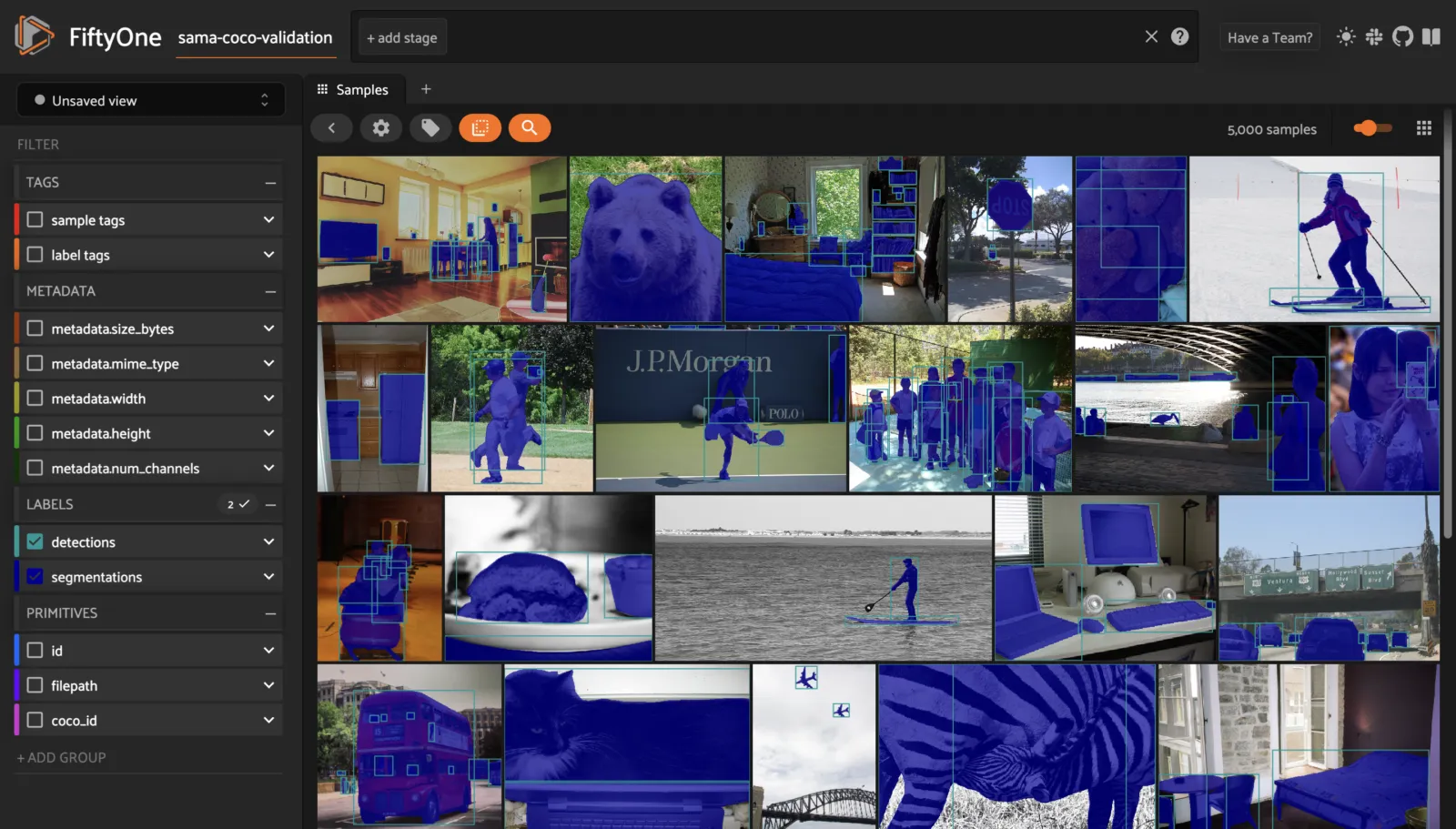
UCF101 ¶¶
UCF101 is an action recognition data set of realistic action videos, collected from YouTube, having 101 action categories. This data set is an extension of UCF50 data set which has 50 action categories.
With 13,320 videos from 101 action categories, UCF101 gives the largest diversity in terms of actions and with the presence of large variations in camera motion, object appearance and pose, object scale, viewpoint, cluttered background, illumination conditions, etc, it is the most challenging data set to date. As most of the available action recognition data sets are not realistic and are staged by actors, UCF101 aims to encourage further research into action recognition by learning and exploring new realistic action categories.
The videos in 101 action categories are grouped into 25 groups, where each group can consist of 4-7 videos of an action. The videos from the same group may share some common features, such as similar background, similar viewpoint, etc.
Details
-
Dataset name:
ucf101 -
Dataset source: https://www.crcv.ucf.edu/research/data-sets/ucf101
-
Dataset size: 6.48 GB
-
Tags:
video, action-recognition -
Supported splits:
train, test -
ZooDataset class:
UCF101Dataset
Example usage
Note
In order to work with video datasets, you’ll need to have ffmpeg installed.
Also, if you don’t already have a utility to uncompress .rar archives,
you may need to install one. For example, on macOS:
brew install rar
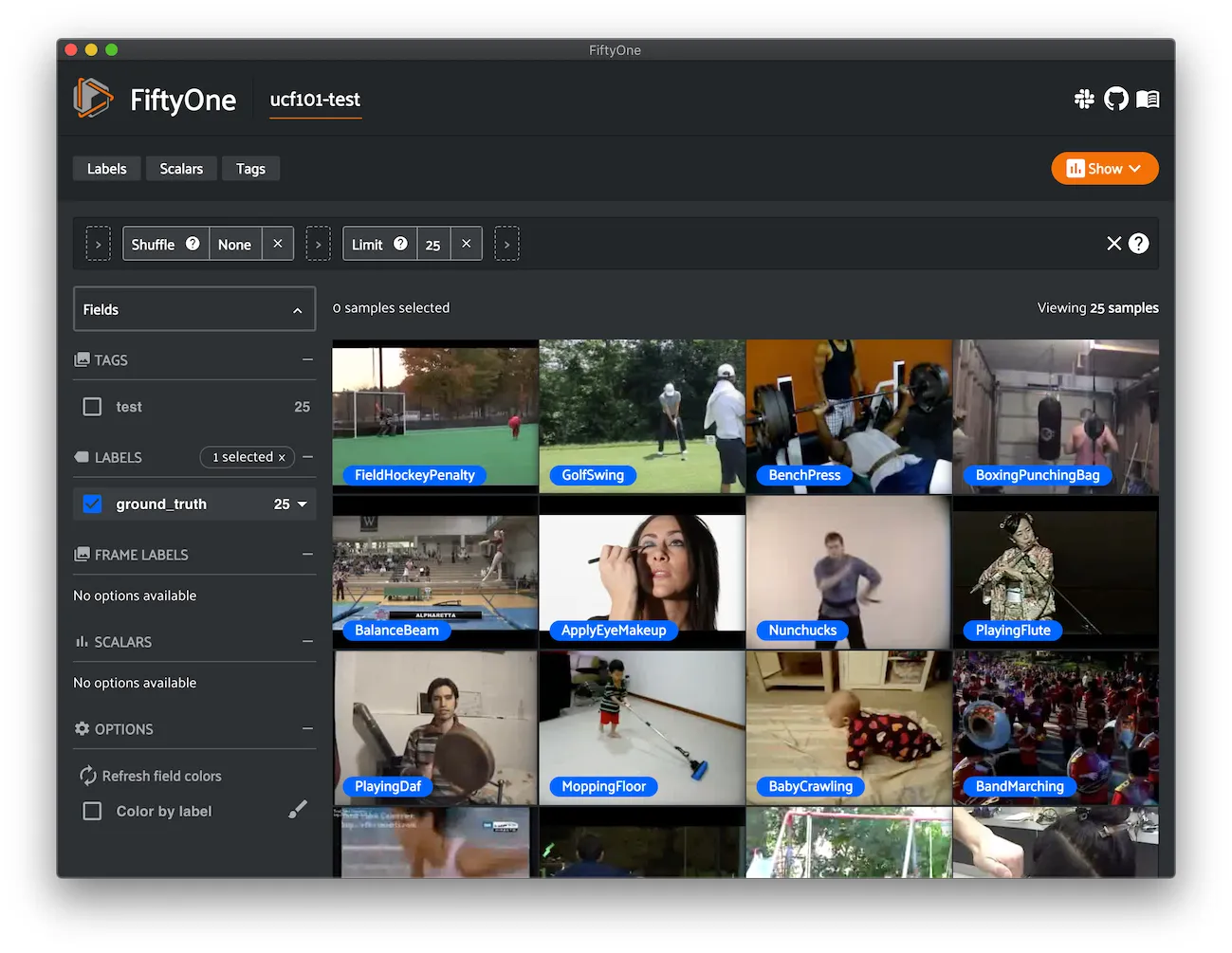
VOC-2007 ¶¶
The dataset for the PASCAL Visual Object Classes Challenge 2007 (VOC2007) for the detection competition.
A total of 9,963 images are included in this dataset, where each image contains a set of objects, out of 20 different classes, making a total of 24,640 annotated objects.
Note that, as per the official dataset, the test set of VOC2007 does not contain annotations.
Details
-
Dataset name:
voc-2007 -
Dataset source: http://host.robots.ox.ac.uk/pascal/VOC/voc2007
-
Dataset size: 868.85 MB
-
Tags:
image, detection -
Supported splits:
train, validation, test -
ZooDataset classes:
-
VOC2007Dataset(TF backend) -
VOC2007Dataset(Torch backend)
Note
The test split is only available via the
TensorFlow backend.
Note
You must have the Torch or TensorFlow backend(s) installed to load this dataset.
Example usage
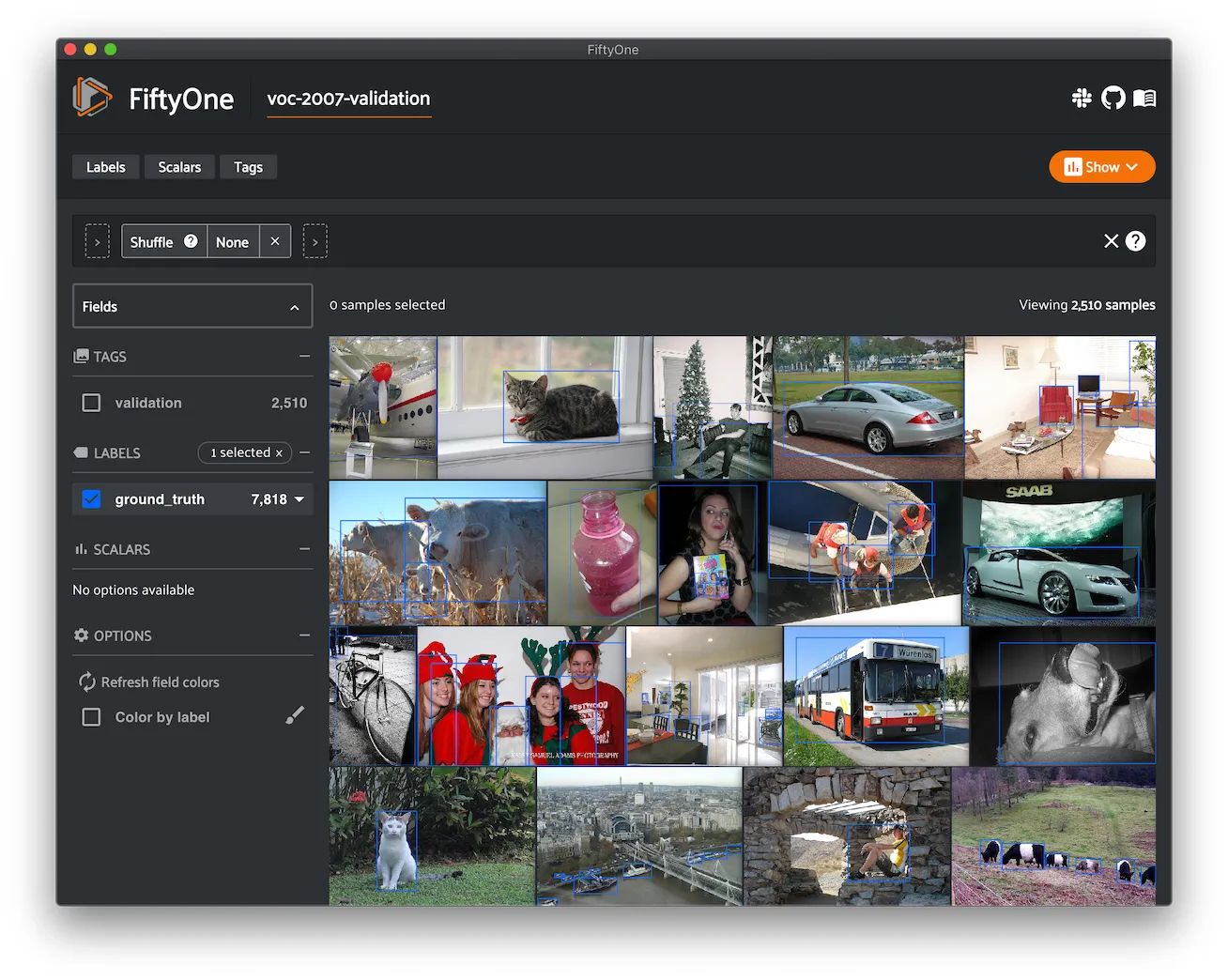
VOC-2012 ¶¶
The dataset for the PASCAL Visual Object Classes Challenge 2012 (VOC2012) for the detection competition.
A total of 11540 images are included in this dataset, where each image contains a set of objects, out of 20 different classes, making a total of 27450 annotated objects.
Note that, as per the official dataset, the test set of VOC2012 does not contain annotations.
Details
-
Dataset name:
voc-2012 -
Dataset source: http://host.robots.ox.ac.uk/pascal/VOC/voc2012
-
Dataset size: 3.59 GB
-
Tags:
image, detection -
Supported splits:
train, validation, test -
ZooDataset classes:
-
VOC2012Dataset(TF backend) -
VOC2012Dataset(Torch backend)
Note
The test split is only available via the
TensorFlow backend.
Note
You must have the Torch or TensorFlow backend(s) installed to load this dataset.
Example usage
